Paul van Yperen's Blog, page 182
October 6, 2020
Michela Belmonte
Michela Belmonte (1925-1978) was an Italian actress and the younger sister of actress Maria Denis. She was discovered by Roberto Rossellini and appeared as a leading lady in a few films during the Fascist era. After the overthrow of Mussolini's regime, she left the film business.
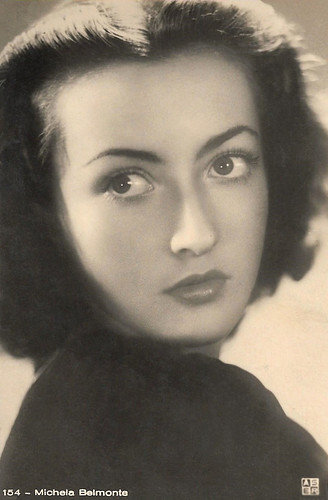
Italian postcard by ASER (A. Scarmiglia Ediuzioni Roma), no. 154.
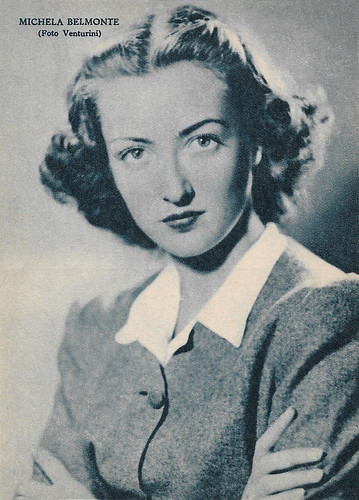
Italian postcard by Rizzoli & C., Milano, 1942. Photo: Venturini.
A brief film career
Michela Belmonte was born as Michela Beomonte in Padoa, Italy, in 1925. She was the younger sister of actress Maria Denis .
After attending secondary school, Belmonte moved to Rome to try to get into film. She was noticed by Roberto Rossellini who hired for a small part opposite male lead Massimo Girotti in Un pilota ritorna/A Pilot Returns (1942). The film, based on a story by il Duce's son, Vittorio Mussolini, avoids any overt reference to or exaltation of the regime, from a screenplay co-written with Michelangelo Antonioni, among others. The film forms a part of Rossellini's 'Fascist trilogy' along with La nave bianca/The White Ship (1941) and L'uomo dalla croce/The Man with a Cross (1943). It was made with the co-operation of the Italian Air Force
Belmonte's small part in Un pilota ritorna/A Pilot Returns was impressive enough for Mario Mattoli to let her play one of the protagonists of the film I 3 acquelotti/The 3 eagles (1942), next to a fresh-faced Alberto Sordi , Carlo Minello, and Leonardo Cortese . She played the woman between the friends Marco, Mario, and Filippo who have a great passion in common, flying. They attend the Air Force Academy of Caserta to become pilots, with the ongoing war and the risk of being called into action.
Alexander Caughey at IMDb : "This semi-propaganda work can best be understood as a willingness of the producers to put a brave face on a worsening situation for Italy, by revealing the human being behind the uniform. Definitely not jingoistic, nor to be considered a fascist picture, rather, a salute to the men of the Aeronautica Italiana, who shortly after the release of this film were to be fighting for the Allied cause."
In 1943 she made her third and final film, Il nostro prossimo/Our neighbour (Gherardo Gherardi, Giuseppe Aldo Rossi, 1943), with Belmonte starring alongside Antonio Gandusio , Maurizio D'Ancora, Rina Morelli and Paolo Stoppa .
Following the overthrow of Benito Mussolini's regime in 1943, Michela Belmonte retired from acting. She left the world of cinema to focus on archeology. Belmonte passed away in 1978 in Alicante, Spain. She was only 52.
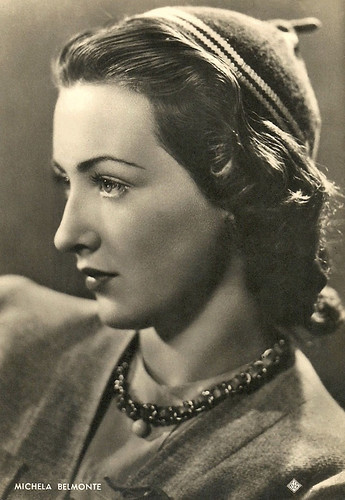
Italian postcard by ASER (A. Scarmiglia Edizioni Roma), no. 112. Photo: Dinami e Malandrino.
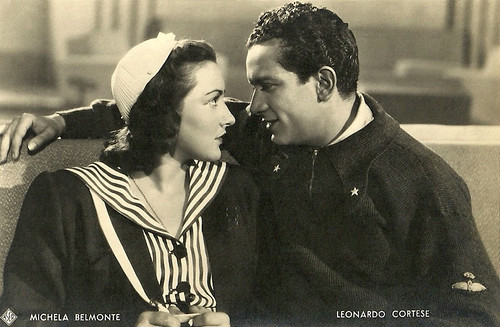
Italian postcard by ASER (A. Scarmiglia Edizoni, Roma), no. 213. Photo: Ciolfi.
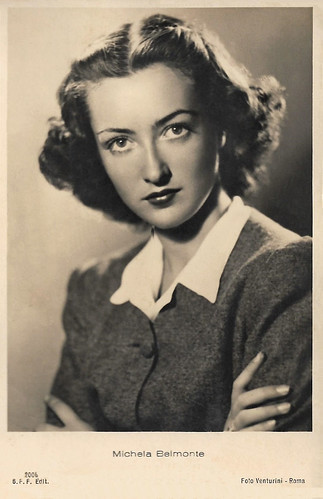
Italian postcard by B.F.F. Edit. (Casa Editr. Ballerini & Fratini, Firenze), no. 2006. Photo: Venturini, Roma.
Sources: Alexander Caughey (IMDb), Wikipedia (Italian and English), and .

Italian postcard by ASER (A. Scarmiglia Ediuzioni Roma), no. 154.

Italian postcard by Rizzoli & C., Milano, 1942. Photo: Venturini.
A brief film career
Michela Belmonte was born as Michela Beomonte in Padoa, Italy, in 1925. She was the younger sister of actress Maria Denis .
After attending secondary school, Belmonte moved to Rome to try to get into film. She was noticed by Roberto Rossellini who hired for a small part opposite male lead Massimo Girotti in Un pilota ritorna/A Pilot Returns (1942). The film, based on a story by il Duce's son, Vittorio Mussolini, avoids any overt reference to or exaltation of the regime, from a screenplay co-written with Michelangelo Antonioni, among others. The film forms a part of Rossellini's 'Fascist trilogy' along with La nave bianca/The White Ship (1941) and L'uomo dalla croce/The Man with a Cross (1943). It was made with the co-operation of the Italian Air Force
Belmonte's small part in Un pilota ritorna/A Pilot Returns was impressive enough for Mario Mattoli to let her play one of the protagonists of the film I 3 acquelotti/The 3 eagles (1942), next to a fresh-faced Alberto Sordi , Carlo Minello, and Leonardo Cortese . She played the woman between the friends Marco, Mario, and Filippo who have a great passion in common, flying. They attend the Air Force Academy of Caserta to become pilots, with the ongoing war and the risk of being called into action.
Alexander Caughey at IMDb : "This semi-propaganda work can best be understood as a willingness of the producers to put a brave face on a worsening situation for Italy, by revealing the human being behind the uniform. Definitely not jingoistic, nor to be considered a fascist picture, rather, a salute to the men of the Aeronautica Italiana, who shortly after the release of this film were to be fighting for the Allied cause."
In 1943 she made her third and final film, Il nostro prossimo/Our neighbour (Gherardo Gherardi, Giuseppe Aldo Rossi, 1943), with Belmonte starring alongside Antonio Gandusio , Maurizio D'Ancora, Rina Morelli and Paolo Stoppa .
Following the overthrow of Benito Mussolini's regime in 1943, Michela Belmonte retired from acting. She left the world of cinema to focus on archeology. Belmonte passed away in 1978 in Alicante, Spain. She was only 52.

Italian postcard by ASER (A. Scarmiglia Edizioni Roma), no. 112. Photo: Dinami e Malandrino.

Italian postcard by ASER (A. Scarmiglia Edizoni, Roma), no. 213. Photo: Ciolfi.

Italian postcard by B.F.F. Edit. (Casa Editr. Ballerini & Fratini, Firenze), no. 2006. Photo: Venturini, Roma.
Sources: Alexander Caughey (IMDb), Wikipedia (Italian and English), and .
Published on October 06, 2020 22:00
October 5, 2020
The Dream Lady (1918)
Carmel Myers and Thomas Holding were the stars in the American romantic comedy The Dream Lady (Elsie Jane Wilson, 1918). The Bluebird Photoplays (Universal) production was based on the novel 'Why Not?' by Margaret Widdener. The Spanish chocolate factory Chocolat Imperiale in Barcelona released a series of 6 Cromos of the film which were printed by Exclusivas Verdaguer SA, Barcelona. The Spanish title of the film is ¿Por qué no..?.
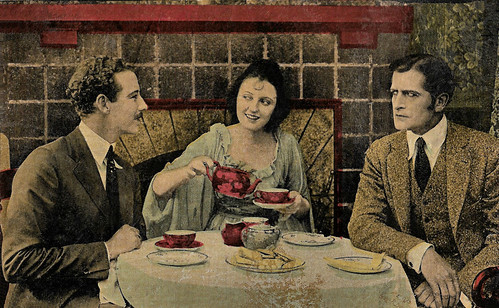
Spanish cromo for Chocolat Imperiale, Barcelona, by Exclusivas Verdaguer SA, Barcelona, no. 1 of 6 cards. Photo: Transatlantic Film. Carmel Myers and Thomas Holding in The Dream Lady (Elsie Jane Wilson, 1918).
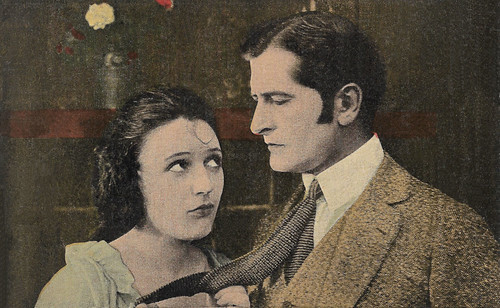
Spanish cromo for Chocolat Imperiale, Barcelona, by Exclusivas Verdaguer SA, Barcelona, no. 2 of 6 cards. Photo: Transatlantic Film. Carmel Myers and Thomas Holding in The Dream Lady (Elsie Jane Wilson, 1918).
A delightfully daffy confection
In The Dream Lady (Elsie Jane Wilson, 1918), Carmel Myers plays the orphan Rosamond, who grows up on her own, without friends, but who has a vivid imagination.
Using a small but substantial inheritance after her uncle dies, heroine Rosamond Gilbert sets up a fortune-telling business. No mere charlatan, Rosamond is a "true believer" and she hopes to use her crystal ball to make her customers' dreams come true.
Her first client is Sydney Brown (Kathleen Mereson), a young woman who, unhappy in love, expresses the desire to become a man. Rosamond dresses the girl in male garb and arranges for her to go into business with her former boyfriend James Mattison (Harry von Meter), who one day confesses he would love to marry a girl with Sydney's qualities...
Rosamond also advises her neighbour, John Squire (Thomas Holding), to invest with a certain Jerrold (Philo McCullough), who proves to be a cheat. John finds out just in time. He forgives Rosamund, and in love with her, even asks her to marry him. As 'marrying a gentleman' was on Rosamund's to-do list, she eagerly accepts.
Considered first a lost film, a print was found and preserved by Les Archives di Film (CNC, Bois d'Arcy, France). Dawn Glory at the blog Is it interesting: "This was a very enjoyable little film, and Elsie Jane Wilson did a commendable job directing it." And Hal Erickson at AllMovie: "This delightfully daffy confection was designed primarily to capitalize on the charms of Carmel Myers , and in this respect, it was a success."
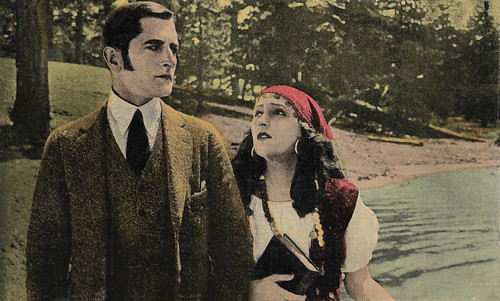
Spanish cromo for Chocolat Imperiale, Barcelona, by Exclusivas Verdaguer SA, Barcelona, no. 4 of 6 cards. Photo: Transatlantic Film. Carmel Myers and Thomas Holding in The Dream Lady (Elsie Jane Wilson, 1918).
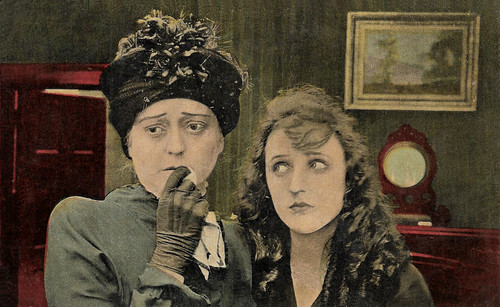
Spanish cromo for Chocolat Imperiale, Barcelona, by Exclusivas Verdaguer SA, Barcelona, no. 5 of 6 cards. Photo: Transatlantic Film. Carmel Myers in The Dream Lady (Elsie Jane Wilson, 1918).
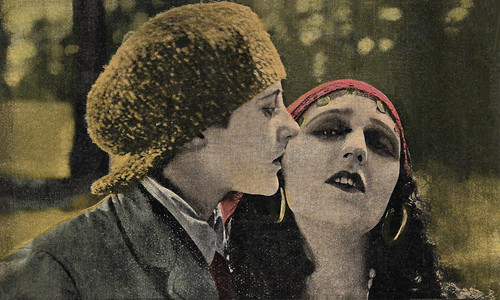
Spanish cromo for Chocolat Imperiale, Barcelona, by Exclusivas Verdaguer SA, Barcelona, no. 6 of 6 cards. Photo: Transatlantic Film. Kathleen Mereson and Carmel Myers in The Dream Lady (Elsie Jane Wilson, 1918).
Sources: Hal Erickson (AllMovies), Dawn Glory (Is it interesting), Wikipedia (Italian and English), and IMDb.

Spanish cromo for Chocolat Imperiale, Barcelona, by Exclusivas Verdaguer SA, Barcelona, no. 1 of 6 cards. Photo: Transatlantic Film. Carmel Myers and Thomas Holding in The Dream Lady (Elsie Jane Wilson, 1918).

Spanish cromo for Chocolat Imperiale, Barcelona, by Exclusivas Verdaguer SA, Barcelona, no. 2 of 6 cards. Photo: Transatlantic Film. Carmel Myers and Thomas Holding in The Dream Lady (Elsie Jane Wilson, 1918).
A delightfully daffy confection
In The Dream Lady (Elsie Jane Wilson, 1918), Carmel Myers plays the orphan Rosamond, who grows up on her own, without friends, but who has a vivid imagination.
Using a small but substantial inheritance after her uncle dies, heroine Rosamond Gilbert sets up a fortune-telling business. No mere charlatan, Rosamond is a "true believer" and she hopes to use her crystal ball to make her customers' dreams come true.
Her first client is Sydney Brown (Kathleen Mereson), a young woman who, unhappy in love, expresses the desire to become a man. Rosamond dresses the girl in male garb and arranges for her to go into business with her former boyfriend James Mattison (Harry von Meter), who one day confesses he would love to marry a girl with Sydney's qualities...
Rosamond also advises her neighbour, John Squire (Thomas Holding), to invest with a certain Jerrold (Philo McCullough), who proves to be a cheat. John finds out just in time. He forgives Rosamund, and in love with her, even asks her to marry him. As 'marrying a gentleman' was on Rosamund's to-do list, she eagerly accepts.
Considered first a lost film, a print was found and preserved by Les Archives di Film (CNC, Bois d'Arcy, France). Dawn Glory at the blog Is it interesting: "This was a very enjoyable little film, and Elsie Jane Wilson did a commendable job directing it." And Hal Erickson at AllMovie: "This delightfully daffy confection was designed primarily to capitalize on the charms of Carmel Myers , and in this respect, it was a success."

Spanish cromo for Chocolat Imperiale, Barcelona, by Exclusivas Verdaguer SA, Barcelona, no. 4 of 6 cards. Photo: Transatlantic Film. Carmel Myers and Thomas Holding in The Dream Lady (Elsie Jane Wilson, 1918).

Spanish cromo for Chocolat Imperiale, Barcelona, by Exclusivas Verdaguer SA, Barcelona, no. 5 of 6 cards. Photo: Transatlantic Film. Carmel Myers in The Dream Lady (Elsie Jane Wilson, 1918).

Spanish cromo for Chocolat Imperiale, Barcelona, by Exclusivas Verdaguer SA, Barcelona, no. 6 of 6 cards. Photo: Transatlantic Film. Kathleen Mereson and Carmel Myers in The Dream Lady (Elsie Jane Wilson, 1918).
Sources: Hal Erickson (AllMovies), Dawn Glory (Is it interesting), Wikipedia (Italian and English), and IMDb.
Published on October 05, 2020 22:00
October 4, 2020
Ricardo Cortez
Ricardo Cortez (1900-1977) was an American screen actor and director, who peaked in the 1920s as Paramount's romantic lover opposite the big female stars of the decade. In the 1930s he rather played tough men such as the first Sam Spade on the screen.
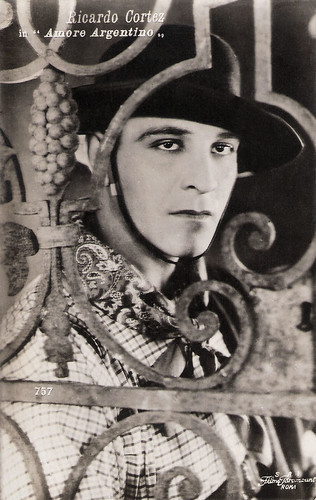
Italian postcard, no. 757. Photo: Films Paramount, Roma. Ricardo Cortez in Argentine Love (Allan Dwan, 1924). Italian release title: Amore Argentino.
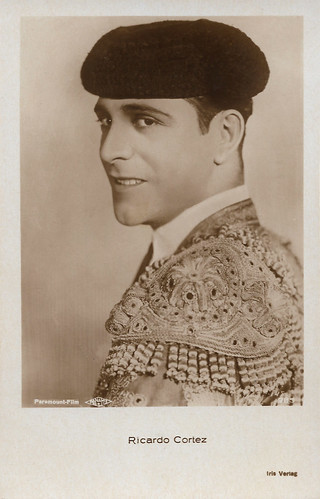
Austrian postcard by Iris Verlag, no. 985. Photo: Fanamet / Paramount-Film. Ricardo Cortez in The Spaniard (Raoul Walsh, 1925).
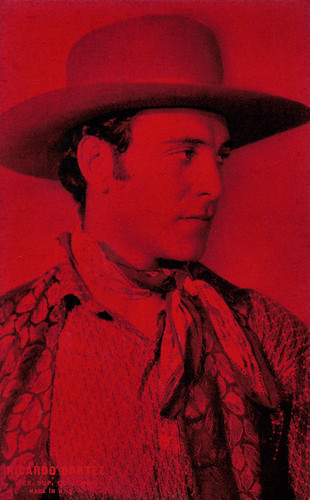
American postcard by Ex. Sup. Co., Chicago. Ricardo Cortez in The Pony Express (James Cruze, 1925).
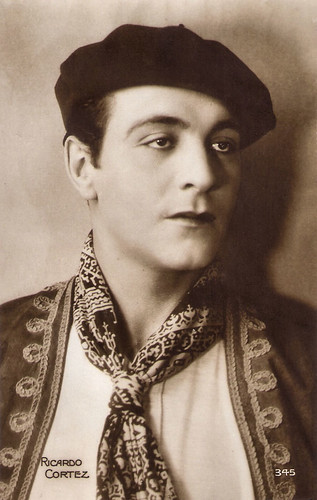
French postcard by Editions Cinémagazine, no. 345. Photo: MGM. Ricardo Cortez in Torrent (Monta Bell, 1926).
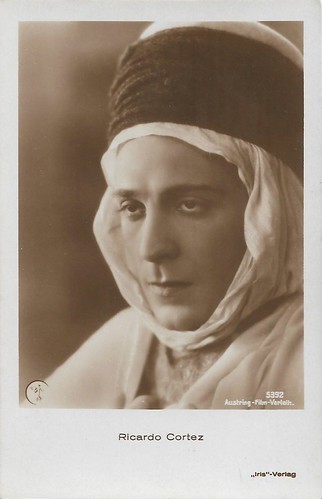
Austrian postcard by Iris Verlag, no. 5392. Photo: Austring Film-Verleih.
An unwilling Latin Lover by the name Jacob Krantz
Italian Wikipedia claims that Ricardi Cortez, born as Jacob Krantz or Kranze, was a Jewish Austrian man, born in 1899 in Vienna, and emigrated to New York in 1900, but English Wikipedia and IMDb contest this and claim he was born in New York City in 1900 from emigrated Austrian-Jewish parents.
Anyway, young Jacob Krantz worked as a runner on Wall Street before entering the film business around 1917 and had his first (uncredited) parts in Californian productions from 1919. Krantz's first credited part was in the Paramount comedy Sixty Cents an Hour (Joseph Henabery, 1923) with Jacqueline Logan and Walter Hiers.
As Krantz started in Hollywood when Rudolph Valentino was at the peak of his popularity, the Teutonic Jacob Krantz was transformed by Paramount into the Spanish Ricardo Cortez. IMDb even claims Jesse Lasky at Paramount deliberately replaced Valentino by Cortez as the former had become too 'difficult and demanding'.
All through the silent era, Ricardo Cortez remained at Paramount and acted in some 5 to 7 films a year. Even if Cortez was not often the star of the film, he was often among the three or four most prominent actors of the film, as in Children of Jazz (Jerome Storm, 1923) with Eileen Percy, The Next Corner (Sam Wood, 1924) with Dorothy Mackaill, A Society Scandal (Allan Dwan, 1924) with Gloria Swanson , and The Bedroom Window (William DeMille, 1924) with May McAvoy and Malcolm McGregor.
Top-billing, Cortez got in The City That Never Sleeps (James Cruze, 1924) opposite Louise Dresser, the Warner production This Woman (Phil Rosen, 1924) opposite Irene Rich, and a growing number of Latin Lover parts, as in Argentine Love (Allan Dwan, 1924) with Bebe Daniels , and The Spaniard (Raoul Walsh, 1925) with Jetta Goudal .
Paramount attempted to turn Cortez into another Latin Lover, but the tall, dark young Cortez did not want to be restricted to that type. Yet, he still often had to play many romantic partners of the leading female stars of the day, e.g. opposite Frances Howard in The Swan (1925), opposite Betty Bronson in the period piece Not So Long Ago (1925), and opposite Greta Nissen in In the Name of Love (1925).
Ricardo Cortez starred as Jack Weston opposite Betty Compson , Ernest Torrence , Wallace Beery and George Bancroft , in the Paramount Western The Pony Express (James Cruze, 1925), billed at the time as "The Rockies and Sierras, sunshine and snow, love and hate, men and beasts, war and peace - all rolled into a character picture which will never be duplicated."
In his next film, he was the male lead opposite Greta Garbo and Gertrude Olmstead in the MGM/Cosmopolitan production Torrent (Monta Bell, 1926). For Garbo, it was her first film in Hollywood, but the film was draped around her star persona and character as a Spanish temptress, while Cortez, despite his Valentino stand-in aura "did something that few romantic stars of the day ever would have done in a film: allow himself to look unattractive, appear foolish and to grow old ungracefully" (TuckMN on IMDb ). The splendid cinematography was done by William Daniels, who would do 20 films with Garbo.
After this sidestep at MGM, Cortez returned to Paramount, where he continued to star in such films as The Cat's Pajamas (William Welman, 1926) with Betty Bronson , The Sorrows of Satan (D.W. Griffith, 1926) with Carol Dempster and Adolphe Menjou , and New York (Luther Reed, 1927).
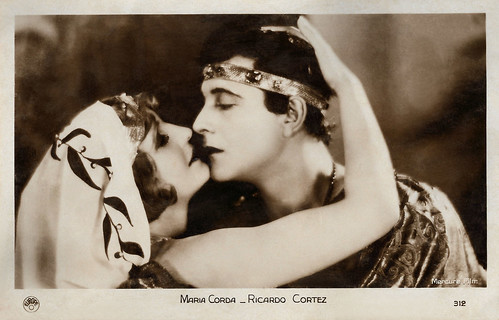
French postcard by Europe, no. 312. Photo: Mercure Film / First National. Maria Corda and Ricardo Cortez in The Private Life of Helen of Troy (Alexander Korda, 1927).
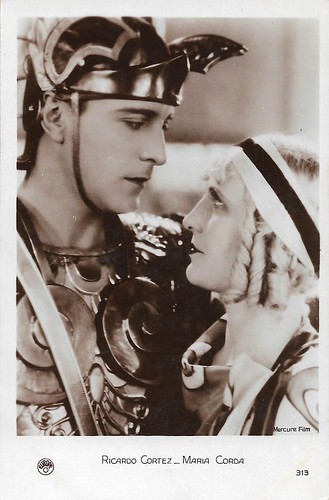
French postcard by Europe, no. 313. Photo: Mercure Film / First National. Maria Corda and Ricardo Cortez in The Private Life of Helen of Troy (Alexander Korda, 1927).
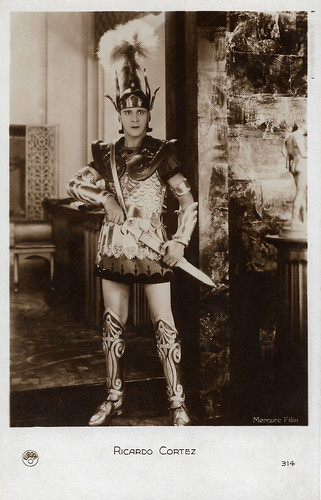
French postcard by Europe, no. 314. Photo: Mercure Film / First National. Ricardo Cortez as Paris in The Private Life of Helen of Troy (Alexander Korda, 1927).
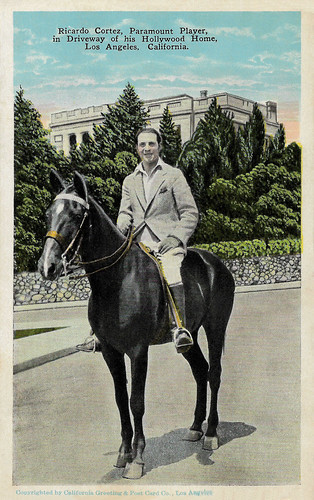
American postcard by California Greeting & Post Card Co., Los Angeles, no. 30508 N. Sent by mail in 1928. Caption: Ricardo Cortez, Paramount Player, in Driveway of his Hollywood Home, Los Angeles, California.
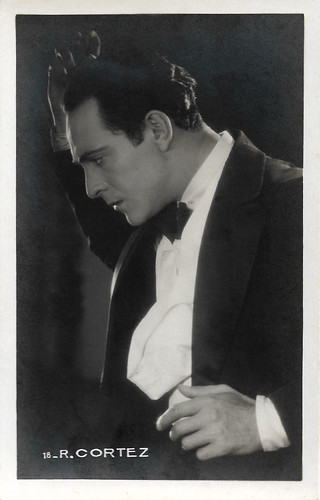
Italian postcard by Ebany, no. 18.
Developing a new type as the womanising tough guy
Apparently, Ricardo Cortez stopped his contract at Paramount in 1927, as he then started to freelance for various companies. He starred opposite the great Lon Chaney in the MGM film Mockery (Benjamin Christensen, 1927), opposite Maria Corda in First National's Antiquity film spoof The Private Life of Helen of Troy (Alexander Korda, 1927), and even opposite Louise Lagrange in an European production, the French film La danseuse Orchidée/Woman of Destiny (Léonce Perret, 1928).
In La danseuse Orchidée/Woman of Destiny, Luicha (Lagrange) returns to her native village in the Basque country where she meets her childhood friend Yoannès (Cortez). The latter, madly in love, wants to marry her, but she disappears suddenly. She has returned to Paris precipitately where she is known as 'the Orchid Dancer'. He starts searching for her and discovers her profession. Interesting is that the film is not focusing on Lagrange but on Cortez, who well managed to show he was capable of all kinds of subtleties in his performance, expressing jealousy, impulsiveness, and fragility.
Returned to Hollywood, Cortez played in his first part-talkie, Ladies of the Night Club (George Archainbaud, 1928), still without spoken dialogue. In his last silent films, Cortez developed a new type, to which he would hold on in the early 1930s as well: that of the womanising tough guy and even the gangster, so no longer the romantic partner of the female stars. The tide had changed and so had types 'en vogue' in the Pre-Code movies of the late 1920s and early 1930s.
Cortez does not seem to have had a big problem with stepping over to sound cinema, but his age was a bit counting. That was even worked into the plots of some of his early 1930s sound films, such as Midstream (James Flood, 1929). Still, in the early 1930s, Cortez remained highly active, doing even ten films in 1931, including Ten Cents a Dance (Lionel Barrymore, Edward Buzzell, 1931) with Barbara Stanwyck as a taxi dancer.
He was even Sam Spade in the first film adaptation of Dashiel Hammett's novel 'The Maltese Falcon', directed by Roy Del Ruth in 1931, and with Bebe Daniels as Ruth Wonderly, the part which would make Mary Astor a star in the later version with Bogart. In 1931 Cortez often acted opposite Astor in films such as Behind Office Doors (Melvile Brown, 1931).
Until the end of 1936, Ricardo Cortez had a very active career, acting in between 5 to 8 films per year, and in addition to parts as antagonists, he was still the star of several films such as Men of Chance (George Archainbaud, 1931), the gangster movie Bad Company (Tay Garnett, 1931), the melodrama Symphony of Six Million (Gregory La Cava, 1932), the thriller The Big Shakedown (1934) alongside Bette Davis , and the detective story Mr. Moto's Last Warning (Norman Foster, 1939).
All in all, Cortez played in some 100 films. Between 1939 and 1940, he tried to go into directing, with a series of B-movies intended for double bill shows, but his attempts behind the camera had disappointing results. During the 1940s he progressively thinned his film appearances, appearing again in the Film Noir The Locket (John Brahm, 1946) and Mystery in Mexico (Robert Wise, 1948).
After that, Cortez returned to Wall Street and became a respected broker. He allowed himself a return to the set solely for a role in John Ford's drama The Last Hurrah (1958) and for an appearance in an episode of the television series Bonanza (1960).
Ricardo Cortez was married to actress Alma Rubens in 1926, until her early death in 1931 because of pneumonia. In 1934 he married Christine Coniff Lee, which ended in a divorce in 1940. His last wife was Margaret Belle, who was with him till his death in 1977. His brother was cinematographer Stanley Cortez, who also changed his original name, Samuel Krantz, and who was responsible for the masterly cinematography of The Magnificent Ambersons (Orson Welles, 1942) and The Night of the Hunter (Charles Laughton, 1955).
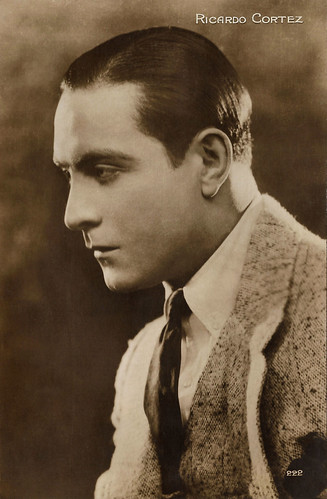
French postcard by Editions Cinémagazine, no. 222.
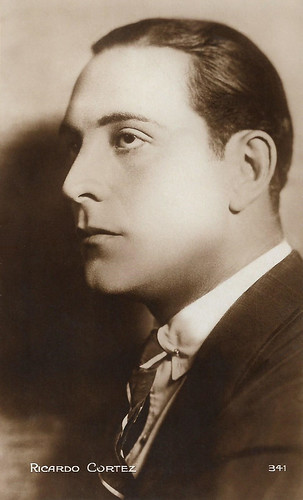
French postcard by Editions Cinémagazine, no. 341.
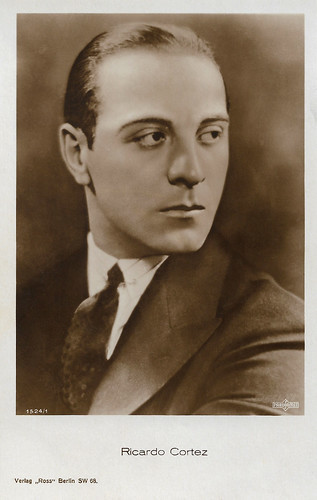
German postcard by Ross Verlag, no. 1524/1, 1927-1928. Photo: Parufamet.
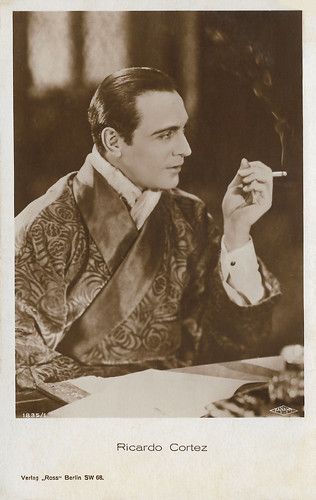
German postcard by Ross Verlag, no. 1835/1, 1927-1928. Photo: Paramount / Fanamet. Ricardo Cortez in The Sorrows of Satan (D.W. Griffith, 1926).
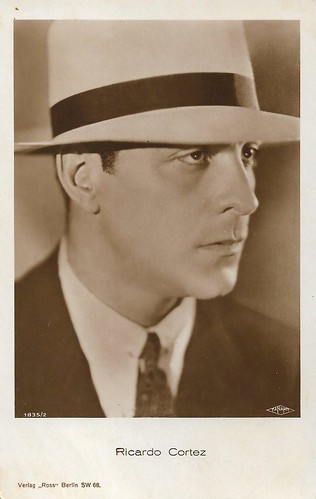
German postcard by Ross Verlag, no. 1835/2, 1927-1928. Photo: Fanamet.
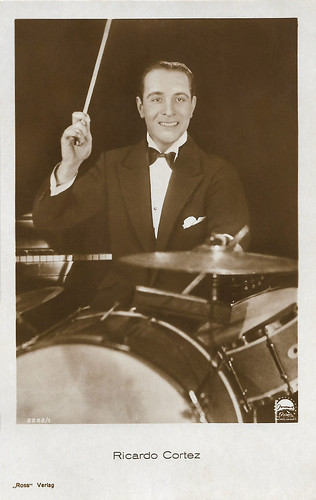
German postcard by Ross Verlag, no. 3262/1, 1928-1929. Photo: Paramount.
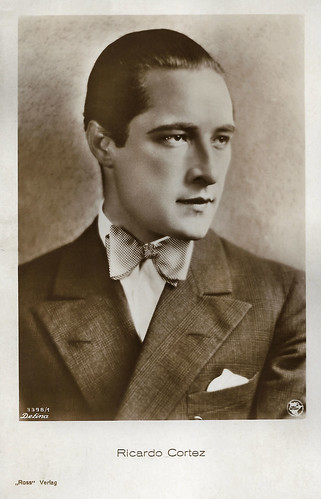
German postcard by Ross Verlag, no. 3398/1, 1928-1929. Photo: Defina / First National.
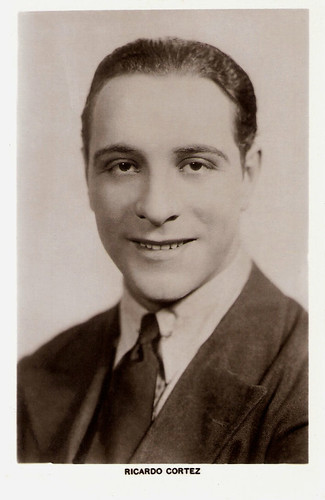
British postcard in the Picturegoer Series, London, no. 214a.
Sources: Ann Hardings Treasures, Wikipedia (English and Italian), and .

Italian postcard, no. 757. Photo: Films Paramount, Roma. Ricardo Cortez in Argentine Love (Allan Dwan, 1924). Italian release title: Amore Argentino.

Austrian postcard by Iris Verlag, no. 985. Photo: Fanamet / Paramount-Film. Ricardo Cortez in The Spaniard (Raoul Walsh, 1925).

American postcard by Ex. Sup. Co., Chicago. Ricardo Cortez in The Pony Express (James Cruze, 1925).

French postcard by Editions Cinémagazine, no. 345. Photo: MGM. Ricardo Cortez in Torrent (Monta Bell, 1926).

Austrian postcard by Iris Verlag, no. 5392. Photo: Austring Film-Verleih.
An unwilling Latin Lover by the name Jacob Krantz
Italian Wikipedia claims that Ricardi Cortez, born as Jacob Krantz or Kranze, was a Jewish Austrian man, born in 1899 in Vienna, and emigrated to New York in 1900, but English Wikipedia and IMDb contest this and claim he was born in New York City in 1900 from emigrated Austrian-Jewish parents.
Anyway, young Jacob Krantz worked as a runner on Wall Street before entering the film business around 1917 and had his first (uncredited) parts in Californian productions from 1919. Krantz's first credited part was in the Paramount comedy Sixty Cents an Hour (Joseph Henabery, 1923) with Jacqueline Logan and Walter Hiers.
As Krantz started in Hollywood when Rudolph Valentino was at the peak of his popularity, the Teutonic Jacob Krantz was transformed by Paramount into the Spanish Ricardo Cortez. IMDb even claims Jesse Lasky at Paramount deliberately replaced Valentino by Cortez as the former had become too 'difficult and demanding'.
All through the silent era, Ricardo Cortez remained at Paramount and acted in some 5 to 7 films a year. Even if Cortez was not often the star of the film, he was often among the three or four most prominent actors of the film, as in Children of Jazz (Jerome Storm, 1923) with Eileen Percy, The Next Corner (Sam Wood, 1924) with Dorothy Mackaill, A Society Scandal (Allan Dwan, 1924) with Gloria Swanson , and The Bedroom Window (William DeMille, 1924) with May McAvoy and Malcolm McGregor.
Top-billing, Cortez got in The City That Never Sleeps (James Cruze, 1924) opposite Louise Dresser, the Warner production This Woman (Phil Rosen, 1924) opposite Irene Rich, and a growing number of Latin Lover parts, as in Argentine Love (Allan Dwan, 1924) with Bebe Daniels , and The Spaniard (Raoul Walsh, 1925) with Jetta Goudal .
Paramount attempted to turn Cortez into another Latin Lover, but the tall, dark young Cortez did not want to be restricted to that type. Yet, he still often had to play many romantic partners of the leading female stars of the day, e.g. opposite Frances Howard in The Swan (1925), opposite Betty Bronson in the period piece Not So Long Ago (1925), and opposite Greta Nissen in In the Name of Love (1925).
Ricardo Cortez starred as Jack Weston opposite Betty Compson , Ernest Torrence , Wallace Beery and George Bancroft , in the Paramount Western The Pony Express (James Cruze, 1925), billed at the time as "The Rockies and Sierras, sunshine and snow, love and hate, men and beasts, war and peace - all rolled into a character picture which will never be duplicated."
In his next film, he was the male lead opposite Greta Garbo and Gertrude Olmstead in the MGM/Cosmopolitan production Torrent (Monta Bell, 1926). For Garbo, it was her first film in Hollywood, but the film was draped around her star persona and character as a Spanish temptress, while Cortez, despite his Valentino stand-in aura "did something that few romantic stars of the day ever would have done in a film: allow himself to look unattractive, appear foolish and to grow old ungracefully" (TuckMN on IMDb ). The splendid cinematography was done by William Daniels, who would do 20 films with Garbo.
After this sidestep at MGM, Cortez returned to Paramount, where he continued to star in such films as The Cat's Pajamas (William Welman, 1926) with Betty Bronson , The Sorrows of Satan (D.W. Griffith, 1926) with Carol Dempster and Adolphe Menjou , and New York (Luther Reed, 1927).

French postcard by Europe, no. 312. Photo: Mercure Film / First National. Maria Corda and Ricardo Cortez in The Private Life of Helen of Troy (Alexander Korda, 1927).

French postcard by Europe, no. 313. Photo: Mercure Film / First National. Maria Corda and Ricardo Cortez in The Private Life of Helen of Troy (Alexander Korda, 1927).

French postcard by Europe, no. 314. Photo: Mercure Film / First National. Ricardo Cortez as Paris in The Private Life of Helen of Troy (Alexander Korda, 1927).

American postcard by California Greeting & Post Card Co., Los Angeles, no. 30508 N. Sent by mail in 1928. Caption: Ricardo Cortez, Paramount Player, in Driveway of his Hollywood Home, Los Angeles, California.

Italian postcard by Ebany, no. 18.
Developing a new type as the womanising tough guy
Apparently, Ricardo Cortez stopped his contract at Paramount in 1927, as he then started to freelance for various companies. He starred opposite the great Lon Chaney in the MGM film Mockery (Benjamin Christensen, 1927), opposite Maria Corda in First National's Antiquity film spoof The Private Life of Helen of Troy (Alexander Korda, 1927), and even opposite Louise Lagrange in an European production, the French film La danseuse Orchidée/Woman of Destiny (Léonce Perret, 1928).
In La danseuse Orchidée/Woman of Destiny, Luicha (Lagrange) returns to her native village in the Basque country where she meets her childhood friend Yoannès (Cortez). The latter, madly in love, wants to marry her, but she disappears suddenly. She has returned to Paris precipitately where she is known as 'the Orchid Dancer'. He starts searching for her and discovers her profession. Interesting is that the film is not focusing on Lagrange but on Cortez, who well managed to show he was capable of all kinds of subtleties in his performance, expressing jealousy, impulsiveness, and fragility.
Returned to Hollywood, Cortez played in his first part-talkie, Ladies of the Night Club (George Archainbaud, 1928), still without spoken dialogue. In his last silent films, Cortez developed a new type, to which he would hold on in the early 1930s as well: that of the womanising tough guy and even the gangster, so no longer the romantic partner of the female stars. The tide had changed and so had types 'en vogue' in the Pre-Code movies of the late 1920s and early 1930s.
Cortez does not seem to have had a big problem with stepping over to sound cinema, but his age was a bit counting. That was even worked into the plots of some of his early 1930s sound films, such as Midstream (James Flood, 1929). Still, in the early 1930s, Cortez remained highly active, doing even ten films in 1931, including Ten Cents a Dance (Lionel Barrymore, Edward Buzzell, 1931) with Barbara Stanwyck as a taxi dancer.
He was even Sam Spade in the first film adaptation of Dashiel Hammett's novel 'The Maltese Falcon', directed by Roy Del Ruth in 1931, and with Bebe Daniels as Ruth Wonderly, the part which would make Mary Astor a star in the later version with Bogart. In 1931 Cortez often acted opposite Astor in films such as Behind Office Doors (Melvile Brown, 1931).
Until the end of 1936, Ricardo Cortez had a very active career, acting in between 5 to 8 films per year, and in addition to parts as antagonists, he was still the star of several films such as Men of Chance (George Archainbaud, 1931), the gangster movie Bad Company (Tay Garnett, 1931), the melodrama Symphony of Six Million (Gregory La Cava, 1932), the thriller The Big Shakedown (1934) alongside Bette Davis , and the detective story Mr. Moto's Last Warning (Norman Foster, 1939).
All in all, Cortez played in some 100 films. Between 1939 and 1940, he tried to go into directing, with a series of B-movies intended for double bill shows, but his attempts behind the camera had disappointing results. During the 1940s he progressively thinned his film appearances, appearing again in the Film Noir The Locket (John Brahm, 1946) and Mystery in Mexico (Robert Wise, 1948).
After that, Cortez returned to Wall Street and became a respected broker. He allowed himself a return to the set solely for a role in John Ford's drama The Last Hurrah (1958) and for an appearance in an episode of the television series Bonanza (1960).
Ricardo Cortez was married to actress Alma Rubens in 1926, until her early death in 1931 because of pneumonia. In 1934 he married Christine Coniff Lee, which ended in a divorce in 1940. His last wife was Margaret Belle, who was with him till his death in 1977. His brother was cinematographer Stanley Cortez, who also changed his original name, Samuel Krantz, and who was responsible for the masterly cinematography of The Magnificent Ambersons (Orson Welles, 1942) and The Night of the Hunter (Charles Laughton, 1955).

French postcard by Editions Cinémagazine, no. 222.

French postcard by Editions Cinémagazine, no. 341.

German postcard by Ross Verlag, no. 1524/1, 1927-1928. Photo: Parufamet.

German postcard by Ross Verlag, no. 1835/1, 1927-1928. Photo: Paramount / Fanamet. Ricardo Cortez in The Sorrows of Satan (D.W. Griffith, 1926).

German postcard by Ross Verlag, no. 1835/2, 1927-1928. Photo: Fanamet.

German postcard by Ross Verlag, no. 3262/1, 1928-1929. Photo: Paramount.

German postcard by Ross Verlag, no. 3398/1, 1928-1929. Photo: Defina / First National.

British postcard in the Picturegoer Series, London, no. 214a.
Sources: Ann Hardings Treasures, Wikipedia (English and Italian), and .
Published on October 04, 2020 22:00
October 3, 2020
Humphrey Bogart
Humphrey Bogart (1899-1957) is an icon of the Hollywood cinema. His private detectives, Sam Spade in The Maltese Falcon (1941) and Phillip Marlowe in The Big Sleep (1946), became the models for detectives in other Film-Noirs. Bogart and 19-year-old Lauren Bacall fell in love when they filmed To Have and Have Not (1944), the first of a series of films together. He won the best actor Oscar for The African Queen (1951). He was also nominated for Casablanca (1942) and as Captain Queeg in Mutiny on the Caine (1954).
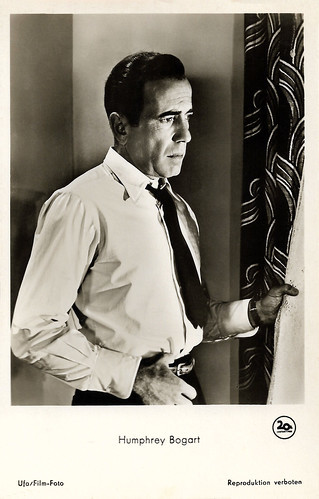
German postcard by UFA/Film-Foto, Berlin-Tempelhof, no. FK 305. Photo: 20th Century Fox. Humphrey Bogart in The Maltese Falcon (John Huston, 1941).
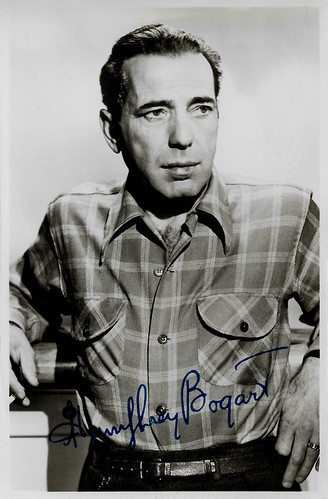
British postcard by Astra. Caption: Humphrey Bogart, the Tough Guy for some of Hollywood's finest thrillers, has just earned fresh laurels for his work in the 'all-male' epic, "Treasure of Sierra Madre."
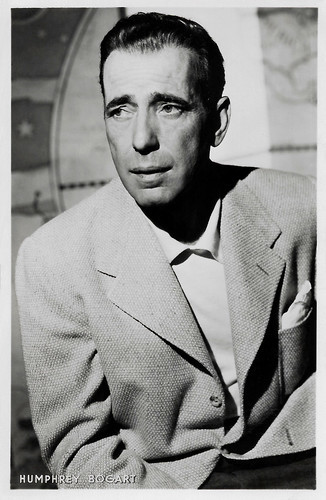
Dutch postcard. Photo: Warner Bros.
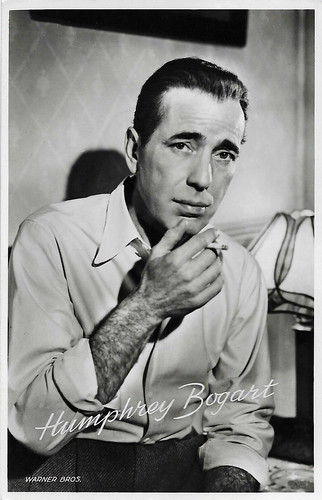
Dutch postcard, no. 3428. Photo: Warner Bros.
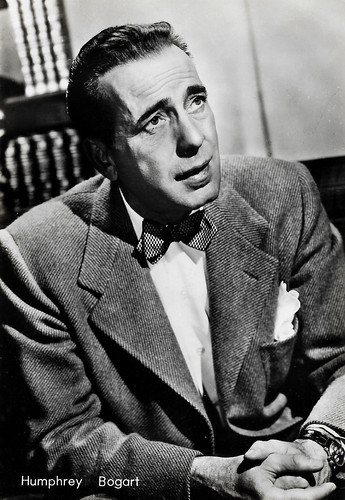
Italian postcard by Bromostampa, Milano, no. 103.
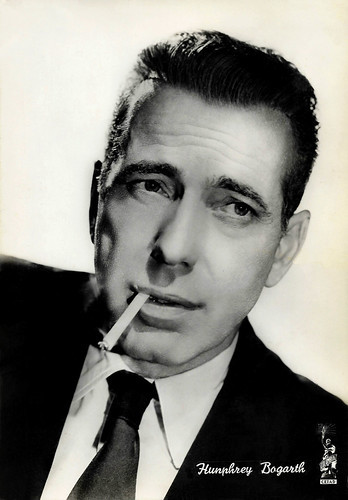
Italian postcard by Rotalfoto, Milano, no. 72. Photo: Columbia / CEIAD.
Inadequate acting
Humphrey DeForest Bogart was born in New York City, New York, in 1899. His mother was Maud Humphrey, a famed magazine illustrator and suffragette, and his father Belmont DeForest Bogart, a moderately wealthy surgeon who was secretly addicted to opium. He had two younger sisters, Frances and Catherine 'Kay' Bogart.
Maud Bogart's drawing of her baby Humphrey appeared in a national advertising campaign for Mellin's Baby Food. 'Bogie' was educated at Trinity School, NYC, and was sent to Phillips Academy in Andover, Massachusetts, in preparation for medical studies at Yale. He was expelled from Phillips and joined the U.S. Naval Reserve in 1918.
During the First World War, he served on the troopship USS Leviathan in the North Atlantic. From 1920 to 1922, he managed a stage company owned by family friend William A. Brady (the father of actress Alice Brady), performing a variety of tasks at Brady's film studio in New York.
He then began regular stage performances, but critic Alexander Woollcott described his acting in a 1922 play as inadequate. In 1930, he gained a contract with Fox. He had his film debut in a ten-minute short, Broadway's Like That (Arthur Hurley, 1930), co-starring Ruth Etting and Joan Blondell . Fox released him after two years.
After five years of stage and minor film roles, he had his breakthrough role in The Petrified Forest (Archie Mayo, 1936) from Warner Bros. He won the part over Edward G. Robinson only after the star, Leslie Howard , threatened Warner Bros. that he would quit unless Bogart was given the key role of Duke Mantee, which he had played in the Broadway production with Howard. The film was a major success and led to a long-term contract with Warner Bros.
From 1936 to 1940, Bogart appeared in 28 films, usually as a gangster and twice in Westerns. He even played in a horror film, The Return of Doctor X (Vincent Sherman, 1939), in which he played a rejuvenated, formerly-dead scientist. He averaged a film every two months between 1936 and 1940, sometimes working on two films at the same time. His only substantial role during this period was in Dead End (William Wyler, 1937), as a gangster modeled after Baby Face Nelson. Bogart used these years to begin developing his film persona: a wounded, stoical, cynical, charming, vulnerable, self-mocking loner with a code of honour.
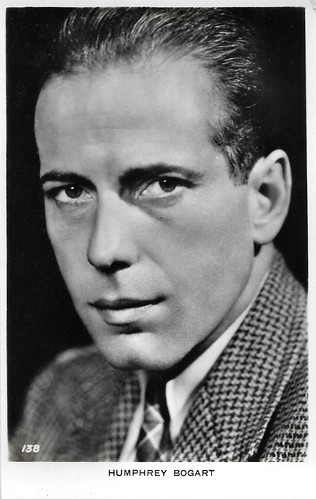
British 'Real Photograph' postcard, no. 138.
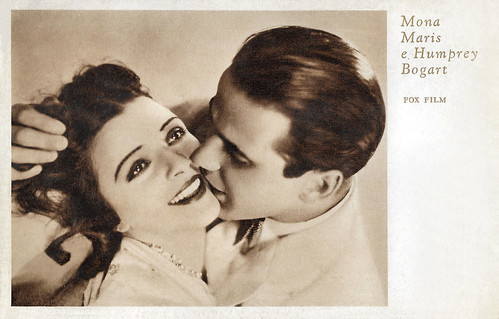
Italian postcard by Cinema-Illustrazione, Milano, no. 16, Serie 1. Photo: Fox Film. Mona Maris and Humphrey Bogart in A Devil with Women (Irving Cummings, 1930).
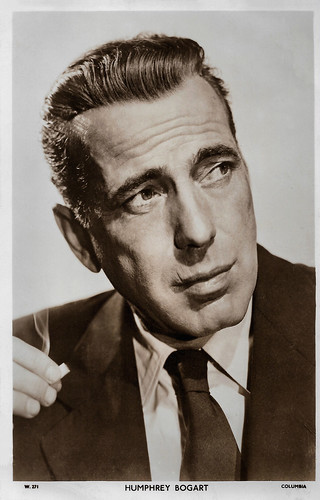
British postcard in the Picturegoer Series, London, no. W. 271. Photo: Columbia.
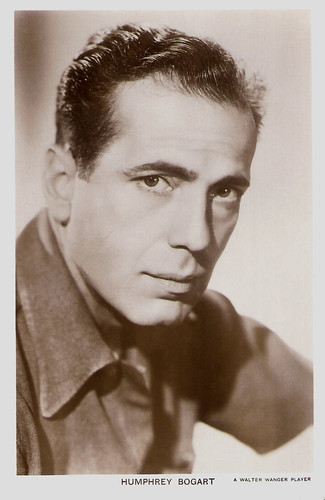
British postcard in the Picturegoer Series, London, no. 1139a. Photo: Walter Wanger.
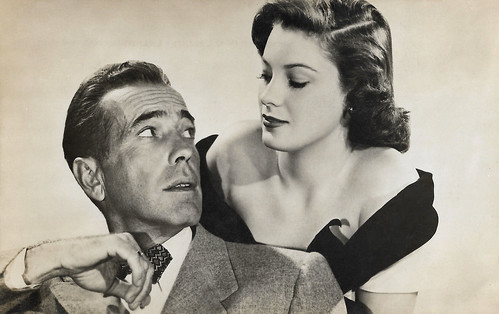
Spanish card by JDP, Valencia, no. 1461. Photo: Humphrey Bogart and Candy Toxton (Susan Perry) in Knock on Any Door (Nicholas Ray, 1949).
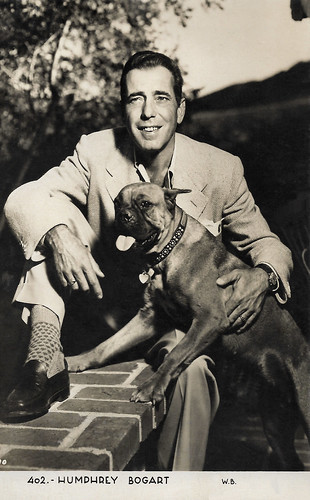
Spanish card, no. 402. Photo: Warner Bros.
I'm No Communist
Humphrey Bogart's landmark year was 1941 with roles in such classics as High Sierra (Raoul Walsh, 1941) with Ida Lupino and as Sam Spade in one of his most fondly remembered films, The Maltese Falcon (John Huston, 1941) with Mary Astor and Peter Lorre .
Thus, he often capitalised on parts George Raft had rejected. Raft had also passed Casablanca (Michael Curtiz, 1942) with Ingrid Bergman , for which Bogart won his first Oscar nomination and which made him a true international star.
In 1944, Bogart fell in love with the 19-year-old Lauren Bacall when they filmed To Have and Have Not (Howard Hawks, 1944). They married in 1945. They also co-starred in the classic Film Noir The Big Sleep (Howard Hawks, 1946), Dark Passage (Delmer Daves, 1947), and Key Largo (John Huston, 1948).
Bogart, despite his erratic education, was incredibly well-read and he favoured writers and intellectuals within his small circle of friends. In 1947, he joined wife Lauren Bacall and other actors protesting the House Un-American Activities Committee witch hunts. They both eventually succumbed to pressure and distanced themselves from the Hollywood Ten in a March 1948 Photoplay Magazine article penned by Bogart titled 'I'm No Communist'.
That year, he made The Treasure of the Sierra Madre (John Huston, 1948) with Walter Huston. He also formed his own production company and produced the Film-Noir Knock on Any Door (Nicholas Ray, 1949). Ray also directed him in one of his best roles in another Film-Noir, In a Lonely Place (Nicholas Ray, 1950) with Gloria Grahame .
Bogie won the Best Actor Academy Award for his part as a cantankerous river steam launch skipper in The African Queen (John Huston, 1951) opposite Katharine Hepburn . He was nominated for another Oscar for his part as Captain Queeg in Mutiny on the Caine (Edward Dmytryk, 1954), a film made when he was already seriously ill.
Other significant roles included The Barefoot Contessa (Joseph L. Mankiewicz, 1954) with Ava Gardner and his on-screen competition with William Holden for Audrey Hepburn in Sabrina (Billy Wilder, 1954).
In 1957, Humphrey Bogart died in his sleep at his Hollywood home following surgeries and a battle with throat cancer. He usually smoked 40 cigarettes a day. Bogart had just turned 57. Bogart is interred at Forest Lawn, Glendale, CA, in the Garden of Memory, Columbarium of Eternal Light. He was four times married and all of his wives were actresses: Helen Menken (1926-1927), Mary Philips (1928-1938), Mayo Methot (1938-1945), and Lauren Ball (1945-1957). Bogart and Bacall, had two children, Stephen H. Bogart (1949) and Leslie Bogart (1952). Stephen discussed his relationship with Bogie in the book, 'Bogart: In Search of My Father' (1996).
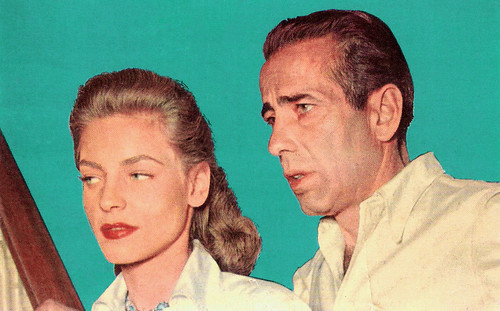
With Lauren Bacall. French postcard by Imp. De Marchi Frères, Marseille.
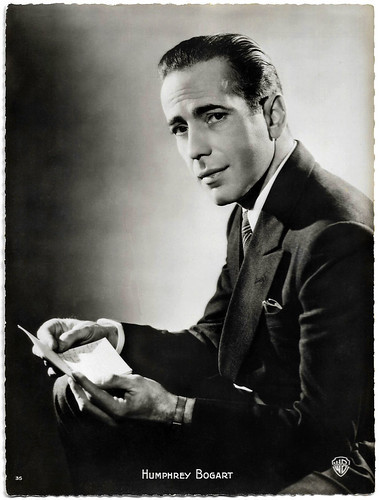
Big Belgian collectors card by Chocolaterie Clovis S.P.R.L., Pepinster, no. 35. Photo: Warner Bros.
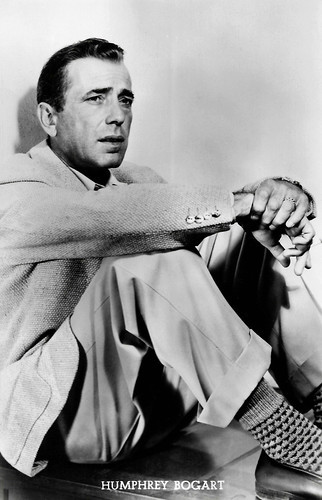
Belgian postcard, no. 51. Photo: Warner Bros.
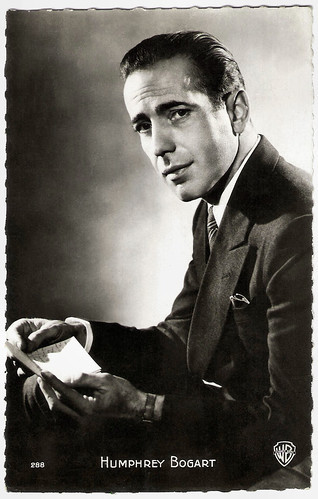
French postcard by Editions P.I., Paris, no. 288. Photo: Warner Bros. We have another Bogart postcard by Editions P.I. with the same number:
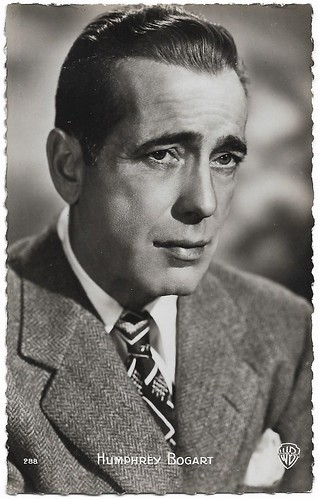
French postcard by Editions P.I., Paris, no. 288. Photo: Warner Bros.
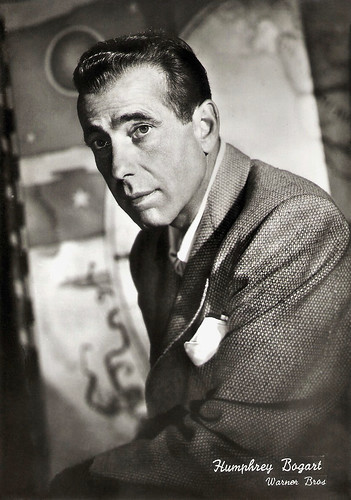
Italian postcard by Bromofoto, Milano, no. 317. Photo: Warner Bros.
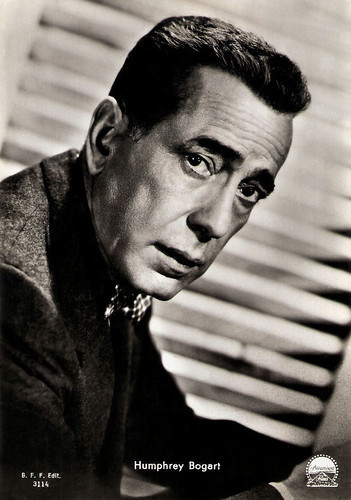
Italian postcard by B.F.F. Edit. (Casa Editr. Ballerini & Fratini, Firenze), no. 3114. Photo: Paramount.
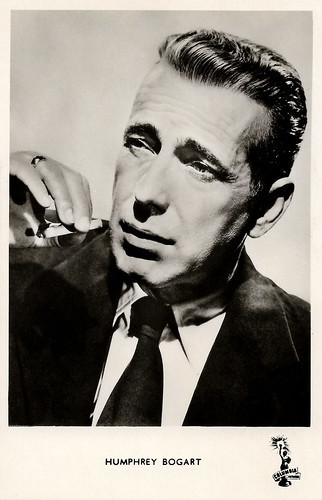
German postcard by Kunst und Bild, Berlin. Photo: Columbia Pictures.
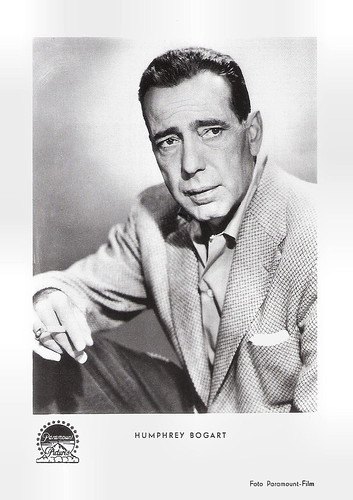
German postcard. Photo: Paramount Pictures.
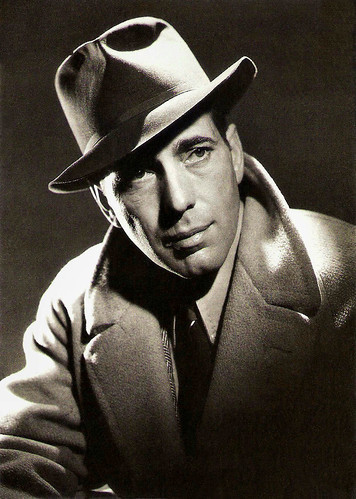
German postcard by Edition Cicero, Hamburg, no. 3114, no. 150.07, 1988. Photo: George Hurrell, 1940 / The Kobal Collection.
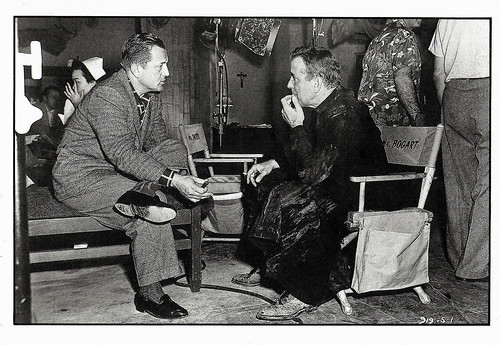
French postcard in the 'Entr'acte' series by Editions Asphodèle, Mâcon. Photo: director Edward Dmytryk and Humphrey Bogart on the set of The Left Hand of God (Edward Dmytryk, 1955). In the background: Gene Tierney. Collection: B. Courtel / D. R.
Sources: (IMDb), Wikipedia, and .

German postcard by UFA/Film-Foto, Berlin-Tempelhof, no. FK 305. Photo: 20th Century Fox. Humphrey Bogart in The Maltese Falcon (John Huston, 1941).

British postcard by Astra. Caption: Humphrey Bogart, the Tough Guy for some of Hollywood's finest thrillers, has just earned fresh laurels for his work in the 'all-male' epic, "Treasure of Sierra Madre."

Dutch postcard. Photo: Warner Bros.

Dutch postcard, no. 3428. Photo: Warner Bros.

Italian postcard by Bromostampa, Milano, no. 103.

Italian postcard by Rotalfoto, Milano, no. 72. Photo: Columbia / CEIAD.
Inadequate acting
Humphrey DeForest Bogart was born in New York City, New York, in 1899. His mother was Maud Humphrey, a famed magazine illustrator and suffragette, and his father Belmont DeForest Bogart, a moderately wealthy surgeon who was secretly addicted to opium. He had two younger sisters, Frances and Catherine 'Kay' Bogart.
Maud Bogart's drawing of her baby Humphrey appeared in a national advertising campaign for Mellin's Baby Food. 'Bogie' was educated at Trinity School, NYC, and was sent to Phillips Academy in Andover, Massachusetts, in preparation for medical studies at Yale. He was expelled from Phillips and joined the U.S. Naval Reserve in 1918.
During the First World War, he served on the troopship USS Leviathan in the North Atlantic. From 1920 to 1922, he managed a stage company owned by family friend William A. Brady (the father of actress Alice Brady), performing a variety of tasks at Brady's film studio in New York.
He then began regular stage performances, but critic Alexander Woollcott described his acting in a 1922 play as inadequate. In 1930, he gained a contract with Fox. He had his film debut in a ten-minute short, Broadway's Like That (Arthur Hurley, 1930), co-starring Ruth Etting and Joan Blondell . Fox released him after two years.
After five years of stage and minor film roles, he had his breakthrough role in The Petrified Forest (Archie Mayo, 1936) from Warner Bros. He won the part over Edward G. Robinson only after the star, Leslie Howard , threatened Warner Bros. that he would quit unless Bogart was given the key role of Duke Mantee, which he had played in the Broadway production with Howard. The film was a major success and led to a long-term contract with Warner Bros.
From 1936 to 1940, Bogart appeared in 28 films, usually as a gangster and twice in Westerns. He even played in a horror film, The Return of Doctor X (Vincent Sherman, 1939), in which he played a rejuvenated, formerly-dead scientist. He averaged a film every two months between 1936 and 1940, sometimes working on two films at the same time. His only substantial role during this period was in Dead End (William Wyler, 1937), as a gangster modeled after Baby Face Nelson. Bogart used these years to begin developing his film persona: a wounded, stoical, cynical, charming, vulnerable, self-mocking loner with a code of honour.

British 'Real Photograph' postcard, no. 138.

Italian postcard by Cinema-Illustrazione, Milano, no. 16, Serie 1. Photo: Fox Film. Mona Maris and Humphrey Bogart in A Devil with Women (Irving Cummings, 1930).

British postcard in the Picturegoer Series, London, no. W. 271. Photo: Columbia.

British postcard in the Picturegoer Series, London, no. 1139a. Photo: Walter Wanger.

Spanish card by JDP, Valencia, no. 1461. Photo: Humphrey Bogart and Candy Toxton (Susan Perry) in Knock on Any Door (Nicholas Ray, 1949).

Spanish card, no. 402. Photo: Warner Bros.
I'm No Communist
Humphrey Bogart's landmark year was 1941 with roles in such classics as High Sierra (Raoul Walsh, 1941) with Ida Lupino and as Sam Spade in one of his most fondly remembered films, The Maltese Falcon (John Huston, 1941) with Mary Astor and Peter Lorre .
Thus, he often capitalised on parts George Raft had rejected. Raft had also passed Casablanca (Michael Curtiz, 1942) with Ingrid Bergman , for which Bogart won his first Oscar nomination and which made him a true international star.
In 1944, Bogart fell in love with the 19-year-old Lauren Bacall when they filmed To Have and Have Not (Howard Hawks, 1944). They married in 1945. They also co-starred in the classic Film Noir The Big Sleep (Howard Hawks, 1946), Dark Passage (Delmer Daves, 1947), and Key Largo (John Huston, 1948).
Bogart, despite his erratic education, was incredibly well-read and he favoured writers and intellectuals within his small circle of friends. In 1947, he joined wife Lauren Bacall and other actors protesting the House Un-American Activities Committee witch hunts. They both eventually succumbed to pressure and distanced themselves from the Hollywood Ten in a March 1948 Photoplay Magazine article penned by Bogart titled 'I'm No Communist'.
That year, he made The Treasure of the Sierra Madre (John Huston, 1948) with Walter Huston. He also formed his own production company and produced the Film-Noir Knock on Any Door (Nicholas Ray, 1949). Ray also directed him in one of his best roles in another Film-Noir, In a Lonely Place (Nicholas Ray, 1950) with Gloria Grahame .
Bogie won the Best Actor Academy Award for his part as a cantankerous river steam launch skipper in The African Queen (John Huston, 1951) opposite Katharine Hepburn . He was nominated for another Oscar for his part as Captain Queeg in Mutiny on the Caine (Edward Dmytryk, 1954), a film made when he was already seriously ill.
Other significant roles included The Barefoot Contessa (Joseph L. Mankiewicz, 1954) with Ava Gardner and his on-screen competition with William Holden for Audrey Hepburn in Sabrina (Billy Wilder, 1954).
In 1957, Humphrey Bogart died in his sleep at his Hollywood home following surgeries and a battle with throat cancer. He usually smoked 40 cigarettes a day. Bogart had just turned 57. Bogart is interred at Forest Lawn, Glendale, CA, in the Garden of Memory, Columbarium of Eternal Light. He was four times married and all of his wives were actresses: Helen Menken (1926-1927), Mary Philips (1928-1938), Mayo Methot (1938-1945), and Lauren Ball (1945-1957). Bogart and Bacall, had two children, Stephen H. Bogart (1949) and Leslie Bogart (1952). Stephen discussed his relationship with Bogie in the book, 'Bogart: In Search of My Father' (1996).

With Lauren Bacall. French postcard by Imp. De Marchi Frères, Marseille.

Big Belgian collectors card by Chocolaterie Clovis S.P.R.L., Pepinster, no. 35. Photo: Warner Bros.

Belgian postcard, no. 51. Photo: Warner Bros.

French postcard by Editions P.I., Paris, no. 288. Photo: Warner Bros. We have another Bogart postcard by Editions P.I. with the same number:

French postcard by Editions P.I., Paris, no. 288. Photo: Warner Bros.

Italian postcard by Bromofoto, Milano, no. 317. Photo: Warner Bros.

Italian postcard by B.F.F. Edit. (Casa Editr. Ballerini & Fratini, Firenze), no. 3114. Photo: Paramount.

German postcard by Kunst und Bild, Berlin. Photo: Columbia Pictures.

German postcard. Photo: Paramount Pictures.

German postcard by Edition Cicero, Hamburg, no. 3114, no. 150.07, 1988. Photo: George Hurrell, 1940 / The Kobal Collection.

French postcard in the 'Entr'acte' series by Editions Asphodèle, Mâcon. Photo: director Edward Dmytryk and Humphrey Bogart on the set of The Left Hand of God (Edward Dmytryk, 1955). In the background: Gene Tierney. Collection: B. Courtel / D. R.
Sources: (IMDb), Wikipedia, and .
Published on October 03, 2020 22:00
October 2, 2020
Enjoy the silence!
Today starts the 39th edition of Le Giornate del Cinema Muto, the silent film festival in the Italian city of Pordenone. This festival will be online. On this first weekend, Saturday and Sunday, and the following Saturday (the 10th), there will be two feature-length screenings, while during the workweek one feature-length programme will be presented, at 8:30 pm. All films and special content will remain available on the site for 24 hours after their online opening, enabling people in all time zones to access the screenings. All films are presented with musical accompaniment; intertitles will be available with both Italian and English subtitles. At EFSP, we will give you a glimpse of the programme.
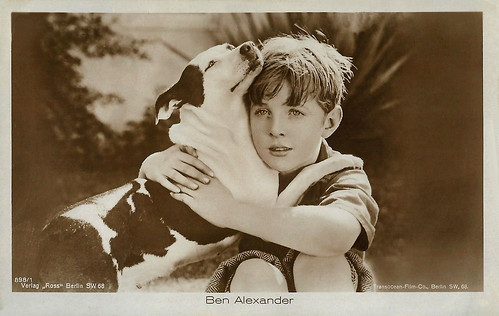
German postcard by Ross Verlag, Berlin, no. 898/1. Photo: Transocean Film Co., Berlin. Ben Alexander in Penrod and Sam (William Beaudine, 1923), based on the novel by Booth Tarkington.
Saturday 3 October: On the Opening Night, Le Giornate del Cinema Muto presents Americana at its best. Penrod and Sam is centered on a group of scamps and the endearing mischief they make. The film, which prefigures Boyhood in its nostalgic look at childhood, surprisingly avoids much of the era’s racial stereotypes. The film was produced by J.K. McDonald Productions and distributed in the US by First National. In 1931 director William Beaudine would make a sound version of this film. Ben Alexander (1911-1969), one of Hollywood's most popular silent child stars, played Penrod.
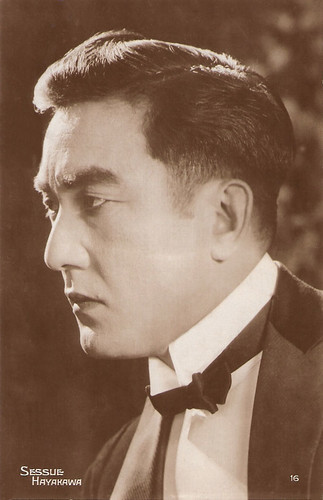
French postcard by Cinémagazine-Edition, no. 16.
Monday 5 October: Sessue Hayakawa achieved global stardom by combining matinee idol glamour with at times problematic ethnic characterizations. In Where Lights Are Low (Colin Campbell, 1921) he’s a Chinese prince seeking to rescue his love from slave traders in San Francisco. Musical accompaniment: Philip Carli.
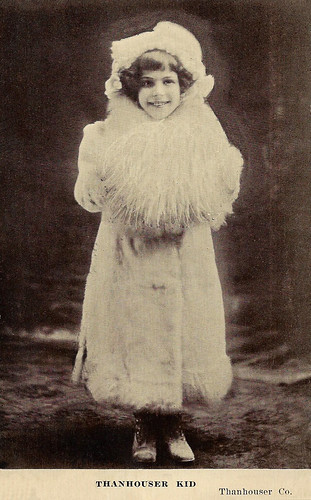
American postcard by Kraus Mfg. Co., N.Y., 1913. Photo: Thanhouser Co.
Monday 5 October: In the Thanhouser short Toodles, Tom and Trouble (Lloyd Lonergan, 1915) pandemonium breaks out when Tom thinks baby Toodles is stolen and all signs suggest that Trouble the collie is to blame. Don’t worry, the Thanhouser dog Lady continued her career after making this short! Marie Eline (1902-1981), nicknamed 'The Thanhouser Kid', was an American silent film child actress and the sister of Grace Eline. She began acting for the Thanhouser Company in New Rochelle, New York, at the age of eight and starred in exactly one hundred films between 1910 and 1914.
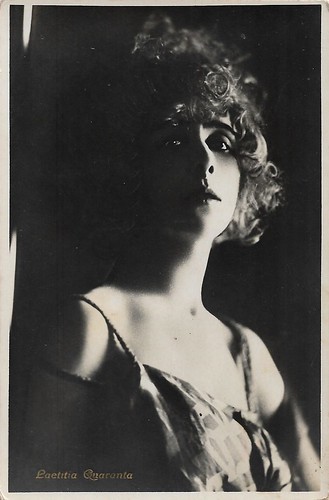
Italian postcard by Ed. G.B. Falci, Milano. Photo: Fotominio.
Tuesday 6 October: Italian actress Letizia Quaranta played a leading role in the comedy La tempesta in un cranio/Kill or Cure (Carlo Campogalliani, 1921). Letizia was the younger sister of film diva Lydia Quaranta and she also peaked in the silent era. Letizia worked for the Turinese companies Itala, Gloria, and Ambrosio, and for the company of her husband, director Carlo Campogalliani. His La tempesta in un cranio/Kill or Cure is an anarchic, quasi-surreal comedy of multiple delights in which the timorous scion of a wealthy family is gaslit by his friends in order to prove that his fears of hereditary insanity are hogwash. Musical accompaniment: Günter A. Buchwald, Frank Bockius.
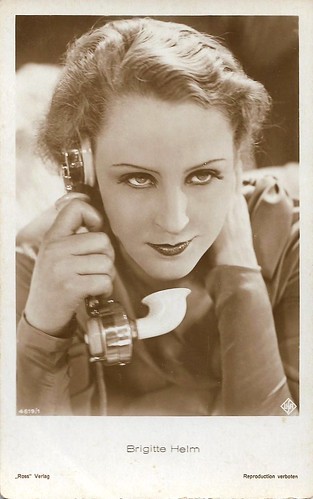
German postcard by Ross Verlag, no. 4619/1, 1929-1930. Photo: Ufa.
Thursday 8 October: German actress Brigitte Helm stars as a woman who embraces hedonism when her husband neglects her in Abwege/The Devious Path (1928). G.W. Pabst’s cynical take on marital unhappiness is presented at Le Giornate del Cinema Muto in a transformative new restoration. Musical accompaniment: Mauro Colombis.
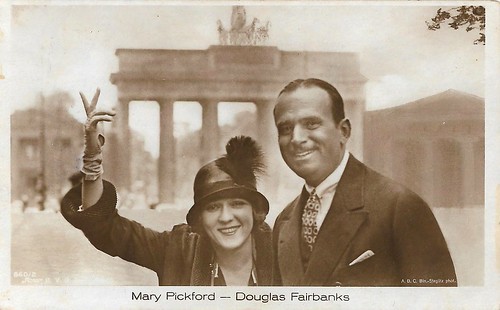
Vintage postcard, Ross Verlag, no. 860/2. Photo by A.B.C. Berlin-Steglitz.
Friday 9 October: Mary Pickford can be seen tonight in A Romance of the Redwoods (1917), directed by Cecil B. DeMille. Presented is a stunning new restoration of this Gold Rush Western, featuring a bold central performance and dramatic location work. Musical accompaniment: Donald Sosin with Joanna Seaton. In 1926, Mary Pickford and her husband. Douglas Fairbanks visited Berlin and stayed at the Hotel Adlon near the Brandenburg Gate, which is in the background of this picture.
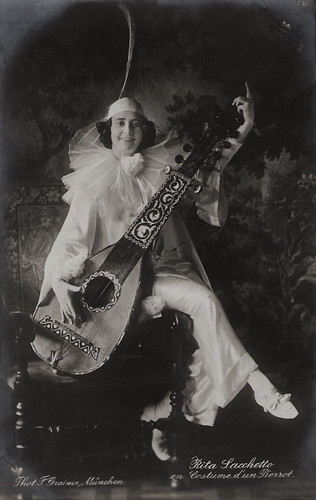
German postcard by Verlag Gastspieldirektion Rita Sacchetto, München, Serie F. 3. Photo: F. Grainer, München (Munich).
Saturday 10 October: German actress and dancer Rita Sacchetto was in the 1910s a star of the Danish Nordisk Film Company. This afternoon is on show Ballettens datter/Daughter of the Ballet (Holger-Madsen, 1913). The festival site: "Director Holger-Madsen’s superb eye for evocative compositions provides the ideal framework for influential dancer Rita Sacchetto , starring as a charismatic ballerina torn between love and her art." The musical accompaniment is by John Sweeney.
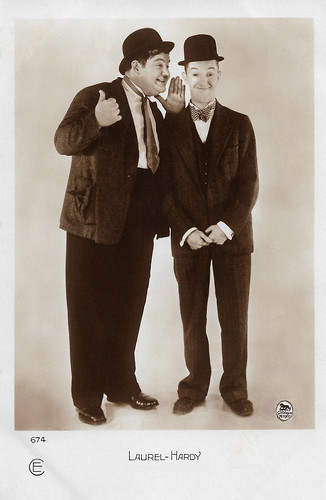
French postcard by Cinémagazine-Edition, Paris, no. 674. Photo: Goldwyn Mayer (MGM). Collection: Geoffrey Donaldson Institute.
Saturday 10 October: The genius of Laurel and Hardy was already in evidence before they first teamed up. On closing night, Le Giornate del Cinema Muto presents 5 riotous shorts predating their legendary partnership, each one joyfully showcasing their individual talents. The Films are The Serenade (1916), The Rent Collector (1921), Detained (1924), Moonlight and Noses (1925), and When Knights Were Cold (1923). Musical accompaniment: Neil Brand.
See the daily schedule of the festival at Le Giornate del Cinema Muto.

German postcard by Ross Verlag, Berlin, no. 898/1. Photo: Transocean Film Co., Berlin. Ben Alexander in Penrod and Sam (William Beaudine, 1923), based on the novel by Booth Tarkington.
Saturday 3 October: On the Opening Night, Le Giornate del Cinema Muto presents Americana at its best. Penrod and Sam is centered on a group of scamps and the endearing mischief they make. The film, which prefigures Boyhood in its nostalgic look at childhood, surprisingly avoids much of the era’s racial stereotypes. The film was produced by J.K. McDonald Productions and distributed in the US by First National. In 1931 director William Beaudine would make a sound version of this film. Ben Alexander (1911-1969), one of Hollywood's most popular silent child stars, played Penrod.

French postcard by Cinémagazine-Edition, no. 16.
Monday 5 October: Sessue Hayakawa achieved global stardom by combining matinee idol glamour with at times problematic ethnic characterizations. In Where Lights Are Low (Colin Campbell, 1921) he’s a Chinese prince seeking to rescue his love from slave traders in San Francisco. Musical accompaniment: Philip Carli.

American postcard by Kraus Mfg. Co., N.Y., 1913. Photo: Thanhouser Co.
Monday 5 October: In the Thanhouser short Toodles, Tom and Trouble (Lloyd Lonergan, 1915) pandemonium breaks out when Tom thinks baby Toodles is stolen and all signs suggest that Trouble the collie is to blame. Don’t worry, the Thanhouser dog Lady continued her career after making this short! Marie Eline (1902-1981), nicknamed 'The Thanhouser Kid', was an American silent film child actress and the sister of Grace Eline. She began acting for the Thanhouser Company in New Rochelle, New York, at the age of eight and starred in exactly one hundred films between 1910 and 1914.

Italian postcard by Ed. G.B. Falci, Milano. Photo: Fotominio.
Tuesday 6 October: Italian actress Letizia Quaranta played a leading role in the comedy La tempesta in un cranio/Kill or Cure (Carlo Campogalliani, 1921). Letizia was the younger sister of film diva Lydia Quaranta and she also peaked in the silent era. Letizia worked for the Turinese companies Itala, Gloria, and Ambrosio, and for the company of her husband, director Carlo Campogalliani. His La tempesta in un cranio/Kill or Cure is an anarchic, quasi-surreal comedy of multiple delights in which the timorous scion of a wealthy family is gaslit by his friends in order to prove that his fears of hereditary insanity are hogwash. Musical accompaniment: Günter A. Buchwald, Frank Bockius.

German postcard by Ross Verlag, no. 4619/1, 1929-1930. Photo: Ufa.
Thursday 8 October: German actress Brigitte Helm stars as a woman who embraces hedonism when her husband neglects her in Abwege/The Devious Path (1928). G.W. Pabst’s cynical take on marital unhappiness is presented at Le Giornate del Cinema Muto in a transformative new restoration. Musical accompaniment: Mauro Colombis.

Vintage postcard, Ross Verlag, no. 860/2. Photo by A.B.C. Berlin-Steglitz.
Friday 9 October: Mary Pickford can be seen tonight in A Romance of the Redwoods (1917), directed by Cecil B. DeMille. Presented is a stunning new restoration of this Gold Rush Western, featuring a bold central performance and dramatic location work. Musical accompaniment: Donald Sosin with Joanna Seaton. In 1926, Mary Pickford and her husband. Douglas Fairbanks visited Berlin and stayed at the Hotel Adlon near the Brandenburg Gate, which is in the background of this picture.

German postcard by Verlag Gastspieldirektion Rita Sacchetto, München, Serie F. 3. Photo: F. Grainer, München (Munich).
Saturday 10 October: German actress and dancer Rita Sacchetto was in the 1910s a star of the Danish Nordisk Film Company. This afternoon is on show Ballettens datter/Daughter of the Ballet (Holger-Madsen, 1913). The festival site: "Director Holger-Madsen’s superb eye for evocative compositions provides the ideal framework for influential dancer Rita Sacchetto , starring as a charismatic ballerina torn between love and her art." The musical accompaniment is by John Sweeney.

French postcard by Cinémagazine-Edition, Paris, no. 674. Photo: Goldwyn Mayer (MGM). Collection: Geoffrey Donaldson Institute.
Saturday 10 October: The genius of Laurel and Hardy was already in evidence before they first teamed up. On closing night, Le Giornate del Cinema Muto presents 5 riotous shorts predating their legendary partnership, each one joyfully showcasing their individual talents. The Films are The Serenade (1916), The Rent Collector (1921), Detained (1924), Moonlight and Noses (1925), and When Knights Were Cold (1923). Musical accompaniment: Neil Brand.
See the daily schedule of the festival at Le Giornate del Cinema Muto.
Published on October 02, 2020 22:00
October 1, 2020
Helga Martin
German actress Helga Martin (1940-1959) was one of the young stars of the Wirtschafswunder cinema in the late 1950s. She played supporting parts in 12 films, mostly comedies, and musicals. Her career was finished after a labour trial in 1960.
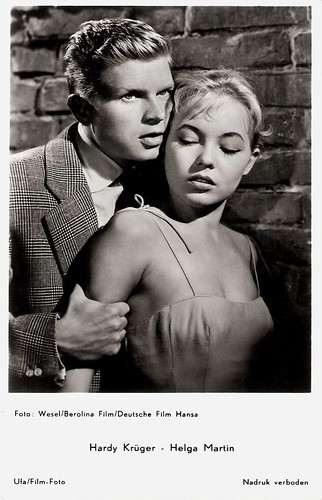
Dutch postcard by Gebr. Spanjersberg N.V., Rotterdam, no. 3747. Photo: Wesel / Berolina Film / Deutsche Film Hansa. Helga Martin and Hardy Krüger in Banktresor 713/Bank Vault 713 (Werner Klingler, 1957).
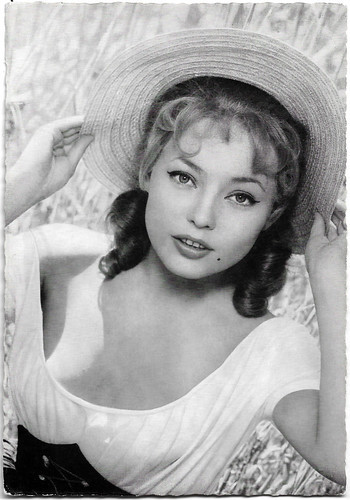
Austrian postcard by Benco Verlag, Wien, no. 477. Photo: Schulz-Film.
Hardy's girlfriend
Helga Martin was born in 1940 in Germany as Helga Dümler.
At 16, she made her film debut with a small part in the comedy Meine Tante, deine Tante/My Aunt, Your Aunt (Carl Boese, 1956) with Theo Lingen and Hans Moser .
The following year, she played the girlfriend of Hardy Krüger in the crime drama Banktresor 713/Bank Vault 713 (Werner Klingler, 1957).
In the next years, he became known for such light entertainment films as Wehe wenn sie losgelassen.../Funny fellows (Géza von Cziffra, 1958) with Peter Alexander , Liebe, Mädchen und Soldaten/Love, girls and soldiers (Franz Antel, 1958) starring Renate Holm, and Ein Sommer, den man nie vergißt/A Summer You Will Never Forget (Werner Jacobs, 1959) with Claus Biederstaedt .
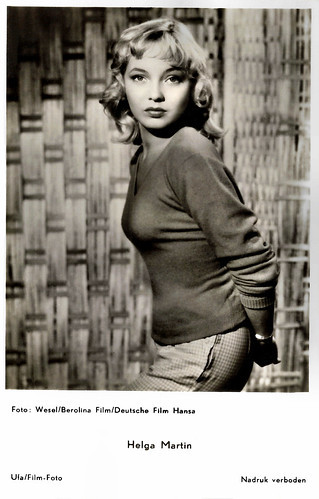
Dutch postcard by Gebr. Spanjersberg N.V., Rotterdam, no. 3745. Spanjersberg was the Dutch licency holder for Ufa/Film-Foto, Berlin-Tempelhof. Photo: Wesel / Berolina Film / Deutsche Film Hansa. Helga Martin in Banktresor 713/Bank Vault 713 (Werner Klingler, 1957).
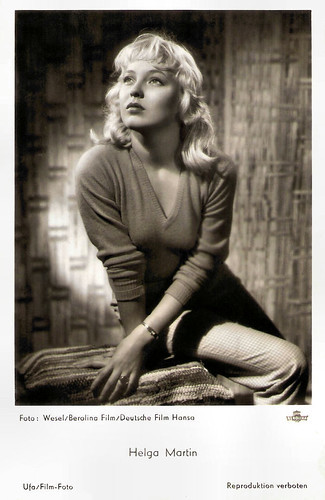
German postcard by Ufa/Film-Foto, Berlin-Tempelhof. no. FK 3746. Photo: Wesel / Berolina Film / Deutsche Film Hansa. Helga Martin in Banktresor 713/Bank Vault 713 (Werner Klingler, 1957).
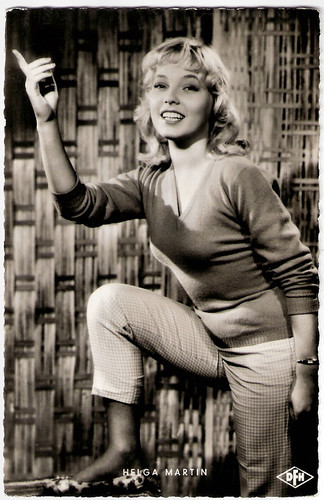
German postcard by Kunst und Bild, Berlin-Charlottenburg, no. I 257. Photo: Bertolina / Deutsche Film Hansa (DFH) / Wesel. Helga Martin in Banktresor 713/Bank Vault 713 (Werner Klingler, 1957).
Germany your little stars
Helga Martin's only lead was in the nostalgic drama Das gab's nur einmal/It Only Happened Once (Géza von Bolváry, 1958) opposite Hans Albers .
After a dozen films, suddenly her film career was over. Journalist and filmmaker Will Tremper had reported about her in the Stern magazine series 'Deutschland deine Sternchen' (Germany your little stars), whereupon the film producer Rudolf Kalmowicz prematurely terminated a film contract with her.
The following labour court trial in 1960 made headlines when Kalmowicz became palpable against Martin's lawyer Lothar Frantz after he doubted his liquidity.
In 1961, she played in a TV film, the comedy Lauter Lügen/All lies (Thomas Engel, 1961), but that was her last screen credit.
Helga Martin died in 1999 in Germany. She was 59. She is buried at the Munich Waldfriedhof .
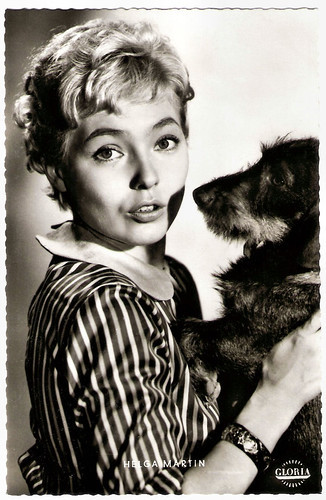
German postcard by Kunst und Bild, Berlin-Charlottenburg, no. A 1729. Photo: Divina / Gloria / Bayer. Helga Martin in Der Haus-Tyrann/The house tyrant (Hans Deppe, 1959).
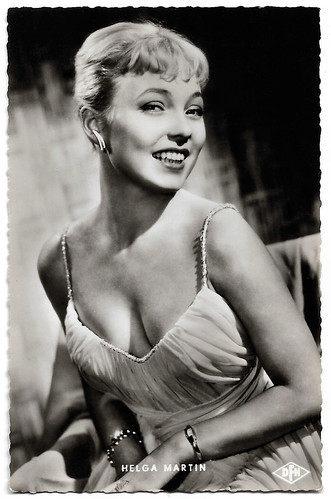
German postcard by Kunst und Bild, Berlin-Charlottenburg, no. S 757. Photo: Wesel / Berolina Film /Deutsche Film Hansa. Helga Martin in Banktresor 713/Bank Vault 713 (Werner Klingler, 1957).
Sources: Wikidata, Wikipedia (German and English), and .

Dutch postcard by Gebr. Spanjersberg N.V., Rotterdam, no. 3747. Photo: Wesel / Berolina Film / Deutsche Film Hansa. Helga Martin and Hardy Krüger in Banktresor 713/Bank Vault 713 (Werner Klingler, 1957).

Austrian postcard by Benco Verlag, Wien, no. 477. Photo: Schulz-Film.
Hardy's girlfriend
Helga Martin was born in 1940 in Germany as Helga Dümler.
At 16, she made her film debut with a small part in the comedy Meine Tante, deine Tante/My Aunt, Your Aunt (Carl Boese, 1956) with Theo Lingen and Hans Moser .
The following year, she played the girlfriend of Hardy Krüger in the crime drama Banktresor 713/Bank Vault 713 (Werner Klingler, 1957).
In the next years, he became known for such light entertainment films as Wehe wenn sie losgelassen.../Funny fellows (Géza von Cziffra, 1958) with Peter Alexander , Liebe, Mädchen und Soldaten/Love, girls and soldiers (Franz Antel, 1958) starring Renate Holm, and Ein Sommer, den man nie vergißt/A Summer You Will Never Forget (Werner Jacobs, 1959) with Claus Biederstaedt .

Dutch postcard by Gebr. Spanjersberg N.V., Rotterdam, no. 3745. Spanjersberg was the Dutch licency holder for Ufa/Film-Foto, Berlin-Tempelhof. Photo: Wesel / Berolina Film / Deutsche Film Hansa. Helga Martin in Banktresor 713/Bank Vault 713 (Werner Klingler, 1957).

German postcard by Ufa/Film-Foto, Berlin-Tempelhof. no. FK 3746. Photo: Wesel / Berolina Film / Deutsche Film Hansa. Helga Martin in Banktresor 713/Bank Vault 713 (Werner Klingler, 1957).

German postcard by Kunst und Bild, Berlin-Charlottenburg, no. I 257. Photo: Bertolina / Deutsche Film Hansa (DFH) / Wesel. Helga Martin in Banktresor 713/Bank Vault 713 (Werner Klingler, 1957).
Germany your little stars
Helga Martin's only lead was in the nostalgic drama Das gab's nur einmal/It Only Happened Once (Géza von Bolváry, 1958) opposite Hans Albers .
After a dozen films, suddenly her film career was over. Journalist and filmmaker Will Tremper had reported about her in the Stern magazine series 'Deutschland deine Sternchen' (Germany your little stars), whereupon the film producer Rudolf Kalmowicz prematurely terminated a film contract with her.
The following labour court trial in 1960 made headlines when Kalmowicz became palpable against Martin's lawyer Lothar Frantz after he doubted his liquidity.
In 1961, she played in a TV film, the comedy Lauter Lügen/All lies (Thomas Engel, 1961), but that was her last screen credit.
Helga Martin died in 1999 in Germany. She was 59. She is buried at the Munich Waldfriedhof .

German postcard by Kunst und Bild, Berlin-Charlottenburg, no. A 1729. Photo: Divina / Gloria / Bayer. Helga Martin in Der Haus-Tyrann/The house tyrant (Hans Deppe, 1959).

German postcard by Kunst und Bild, Berlin-Charlottenburg, no. S 757. Photo: Wesel / Berolina Film /Deutsche Film Hansa. Helga Martin in Banktresor 713/Bank Vault 713 (Werner Klingler, 1957).
Sources: Wikidata, Wikipedia (German and English), and .
Published on October 01, 2020 22:00
September 30, 2020
Directed by D.W. Griffith
Today, we start a new series on directors with a post on American pioneer David Wark Griffith.(1875–1948). After shooting hundreds of shorts at Biograph, in which he experimented with cinematic techniques, Griffith made his mark with the silent classics The Birth of a Nation (1915) and Intolerance (1916). Both were acclaimed for their radical camera and narrative techniques, while the first has also been condemned for its inherently racist philosophy. Several of Griffith's later films were also successful, including Broken Blossoms (1919), Way Down East (1920), and Orphans of the Storm (1921), but his high costs for production, promotion, and roadshow often made his ventures commercial failures. Griffith was also one of the co-founders of United Artists and of AMPAS (Academy of Motion Pictures and Sciences).
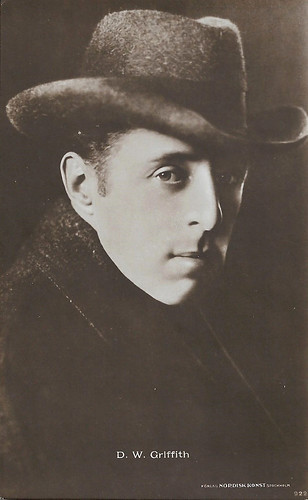
Swedish postcard by Förlag Nordisk Konst, Stockholm, no. 922. A rare portrait of D.W. Griffith.
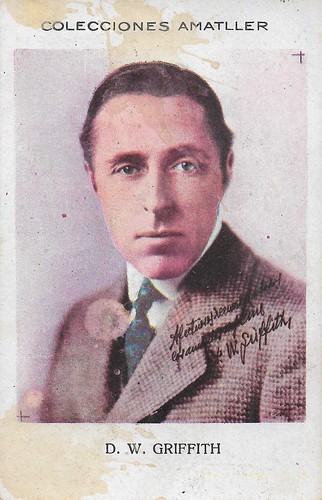
Spanish collectors card by Chocolate Amatller, series B, Artist no. 3, no. 10.
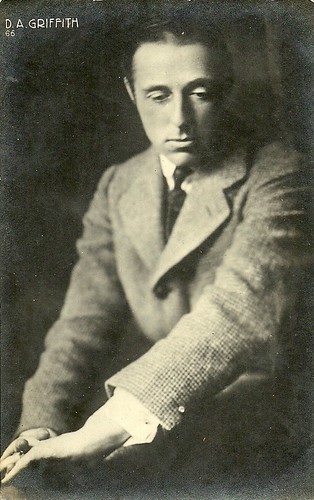
Vintage postcard, no. 66. Collection: Didier Hanson.
The man who invented Hollywood
David Wark Griffith (1975-1948) has been called 'the father of film technique,' 'the man who invented Hollywood,' and 'the Shakespeare of the screen'. These qualifications may have been exaggerated, but still, Griffith is one of the greatest film directors ever.
Born in rural Kentucky to a former Confederate Army colonel and Civil War hero, young Griffith grew up with his father's romantic war stories and melodramatic nineteenth-century literature that were to eventually mould his black-and-white view of human existence and history.
In 1897 Griffith set out to pursue a career both acting and writing for the theatre, but for the most part, he was unsuccessful. Reluctantly, he agreed to work for the new motion picture medium for Edwin S. Porter at the Edison Company. He tried to sell a story to Edison, but they hired him as an actor instead.
Griffith was eventually offered a job at the financially struggling American Mutoscope & Biograph Co. In 1908, Biograph hired him as a first-time director when the chief director fell ill. His directorial debut was The Adventures of Dollie (1908). He stayed and directed over four hundred and fifty short films.
For American Mutoscope & Biograph Co., he produced and directed the first film ever made in Hollywood, In Old California (1910) and he also released his first feature, Judith of Bethulia (1913). He experimented with the story-telling techniques which he would perfect in his epic The Birth of a Nation (1915).
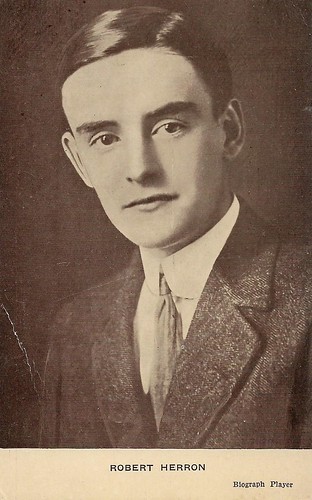
American postcard. Photo: Biograph. Bobby Harron's name is misspelled as Herron.
Robert 'Bobby' Harron (1893-1920) was a teenager when he acted in his first films. He soon appeared in the first films of D. W. Griffith and was to rub shoulders with the great silent stars of the time, notably Lillian Gish . He started to work for Biograph in 1907 and soon became Griffith's favorite, e.g. in In the Lonely Villa (D.W. Griffith, 1909), Bobby, the Coward (D.W. Griffith, 1911), and The Battle of Elderbush Gulch (D.W. Griffith, 1913). In 1912, Robert Harron appeared in nearly forty films at Biograph. Harron is probably best recalled for his roles in the three epic Griffith films: Judith of Bethulia (D.W. Griffith, 1914), opposite Blanche Sweet; the controversial The Birth of a Nation (D.W. Griffith, 1915) with an all-star cast; and the colossal epic Intolerance (D.W. Griffith, 1916). One of Harron's most popular roles was opposite Lillian Gish in the Griffith directed romantic film True Heart Susie (D.W. Griffith, 1919).
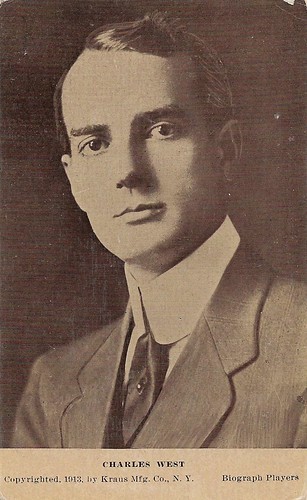
American postcard by Kraus Manufacturing Co., New York, 1913. Photo: Biograph.
American film actor Charles West (1885–1943) appeared in more than 300 films between 1908 and 1937. In 1908, West started to act with D.W. Griffith at Biograph, where he made hundreds of shorts, starting with The Christmas Burglars (D.W. Griffith, 1908), with Florence Lawrence. Being part of the Biograph 'stable' he did many supporting parts but also had leads, as in the Griffith films A Flash of Light (1910), The Broken Cross (1911), The Last Drop of Water (1911), The Blind Princess and the Poet (1911), etc., often being paired with Blanche Sweet. In 1913 he often starred opposite Sweet, Harry Carey and Claire McDowell, and by then direction at Biograph alternated between Griffith and Andy O'Sullivan. In the mid-1910s West remained with Harry Carey as part of the cast of his Westerns at Biograph. In 1916 he moved with Griffith to Triangle, e.g. in The Wood Nymph, produced and scripted by Griffith and starring new star Marie Doro. After a few films, Doro and he moved in 1916 to Jesse Lasky Pictures/ Paramount.
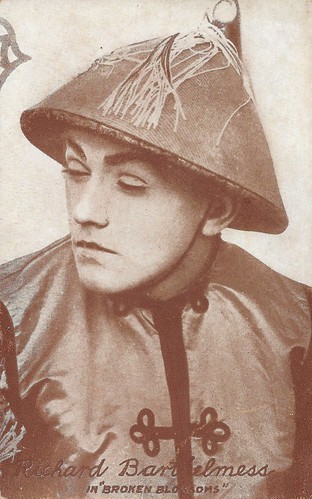
American postcard. Richard Barthelmess in Broken Blossoms (D. W. Griffith, 1919).
Richard Barthelmess (1895-1963) was an American film actor, known for the D.W. Griffith films Broken Blossoms (1919) and Way Down East (1920), and for Tol'able David (Henry King, 1921). He also got Academy Award nominations for The Patent Leather Kid (Alfred Santell, 1927) and The Noose (John Francis Dillon, 1928).
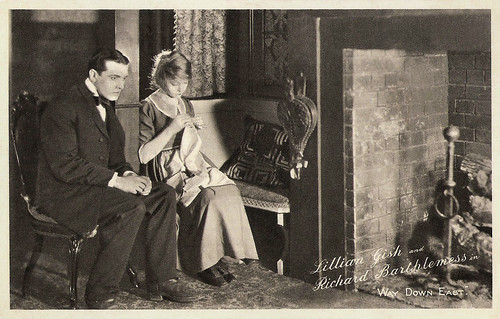
British postcard by Cinema Art, London. Photo: Lillian Gish and Richard Barthelmess in Way Down East (David Wark Griffith, 1920).
The rich, typified by the handsome man-about-town Lennox (Lowell Sherman), are exceptionally selfish and think only of their own pleasure. Anna ( Lillian Gish ) is a poor country girl whom Lennox tricks into a fake wedding. When she becomes pregnant, he leaves her. She has the baby, named Trust Lennox, on her own. When the baby dies she wanders until she gets a job with Squire Bartlett (Burr McIntosh). David ( Richard Barthelmess ), Squire Bartlett's son, falls for her, but she rejects him due to her past. Then Lennox shows up lusting for another local girl, Kate. Seeing Anna, he tries to get her to leave, but she refuses to go, although she promises to say nothing about his past. Finally, Squire Bartlett learns of Anna's past from Martha, the town gossip. In his anger, he tosses Anna out into a snowstorm. Before she goes, she fingers the respected Lennox as her despoiler and the father of her dead baby. Anna becomes lost in the raging storm while David leads a search party. In the famous climax, the unconscious Anna floats on an ice floe down a river towards a waterfall, until rescued at the last moment by David, who marries her in the final scene.
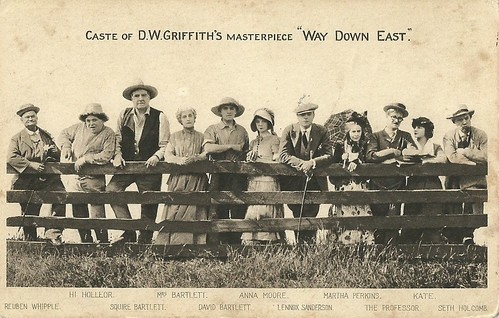
British postcard by Cinema Art, London. From left to right, the actors George Neville, Edgar Nelson, Burr McIntosh, Kate Bruce, Richard Barthelmess , Lillian Gish , Lowell Sherman, Vivia Ogden, Creighton Hale, Mary Hay, and Porter Strong.
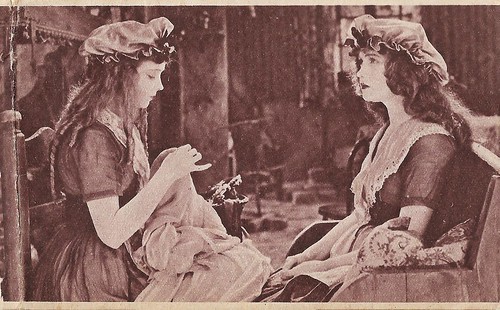
Picture from an unknown magazine, stuck to cardboard card. Lillian Gish and Dorothy Gish in Orphans of the Storm (David Wark Griffith, 1921).
The creator of the flash-back, the iris shot, the mask and cross-cutting
David Wark Griffith and his personal cinematographer G.W. 'Billy' Bitzer collaborated to create and perfect such cinematic devices as the flash-back, the iris shot, the mask and cross-cutting.
The immense popularity of The Birth of a Nation would set the stage for the dominance of the feature-length film in the United States. But after the release of this film, there were also riots in several black neighbourhoods across the country.
When he was criticised as being racist, D.W. Griffith was very hurt. He decided to make Intolerance: Love's Struggle Throughout the Ages (1916) as a follow-up, to show how damaging and dangerous people's intolerance can be.
In the years following The Birth of a Nation, Griffith never again saw the same monumental success as his signature film. Films like Broken Blossoms (1919), Way Down East (1920) and Orphans of the Storm (1921) were also successful, but his high production, promotional, and roadshow costs often made his ventures commercial failures.
In 1920, D.W. Griffith established United Artists with Charles Chaplin , Douglas Fairbanks , and Mary Pickford .
The film America (1924) is regarded as a major turning point in his career. Its failure ended his tenure as the industry's preeminent director. In 1931, his increasing failures forced his retirement. Griffith died in Los Angeles in 1948, one of the most dichotomous figures in film history.
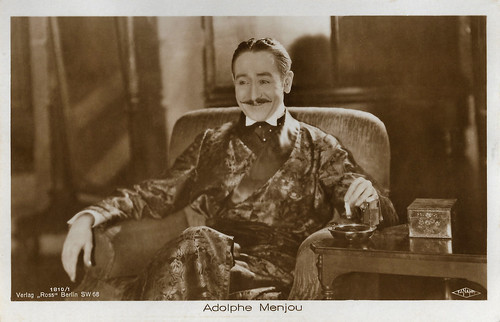
German postcard by Ross Verlag, Berlin, no. 1810/1, 1927-1928. Photo: Fanamet. Adolphe Menjou in The Sorrows of Satan (D.W. Griffith, 1926).

German postcard by Ross Verlag, no. 1835/1, 1927-1928. Photo: Paramount / Fanamet. Ricardo Cortez in The Sorrows of Satan (D.W. Griffith, 1926).
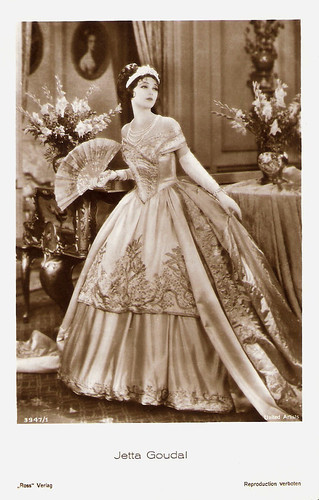
German postcard by Ross Verlag, no. 3947/1, 1928-1929. Photo: United Artists. Jetta Goudal in Lady of the Pavements (D.W. Griffith, 1929).
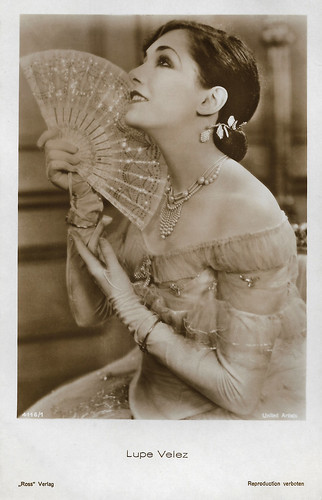
German postcard by Ross Verlag, no. 4116/1, 1929-1930. Photo: United Artists. Lupe Velez in Lady of the Pavements (D.W. Griffith, 1929).
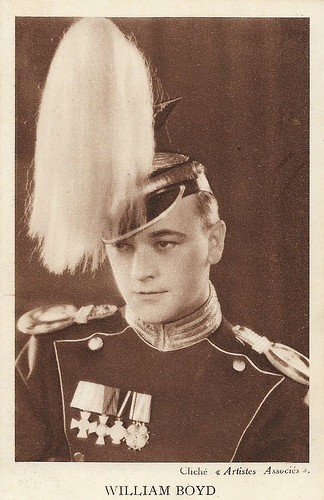
Belgian postcard. Photo Artistes Associés (United Artists). S.A. Cacao et Chocolat Kivou, Vilvoorde / N.V. Cacao en Chocolade Kivou, Vilvoorde. William Boyd in Lady of the Pavements (D.W. Griffith, 1929).
Sources: (IMDb), Wikipedia, and .

Swedish postcard by Förlag Nordisk Konst, Stockholm, no. 922. A rare portrait of D.W. Griffith.

Spanish collectors card by Chocolate Amatller, series B, Artist no. 3, no. 10.

Vintage postcard, no. 66. Collection: Didier Hanson.
The man who invented Hollywood
David Wark Griffith (1975-1948) has been called 'the father of film technique,' 'the man who invented Hollywood,' and 'the Shakespeare of the screen'. These qualifications may have been exaggerated, but still, Griffith is one of the greatest film directors ever.
Born in rural Kentucky to a former Confederate Army colonel and Civil War hero, young Griffith grew up with his father's romantic war stories and melodramatic nineteenth-century literature that were to eventually mould his black-and-white view of human existence and history.
In 1897 Griffith set out to pursue a career both acting and writing for the theatre, but for the most part, he was unsuccessful. Reluctantly, he agreed to work for the new motion picture medium for Edwin S. Porter at the Edison Company. He tried to sell a story to Edison, but they hired him as an actor instead.
Griffith was eventually offered a job at the financially struggling American Mutoscope & Biograph Co. In 1908, Biograph hired him as a first-time director when the chief director fell ill. His directorial debut was The Adventures of Dollie (1908). He stayed and directed over four hundred and fifty short films.
For American Mutoscope & Biograph Co., he produced and directed the first film ever made in Hollywood, In Old California (1910) and he also released his first feature, Judith of Bethulia (1913). He experimented with the story-telling techniques which he would perfect in his epic The Birth of a Nation (1915).

American postcard. Photo: Biograph. Bobby Harron's name is misspelled as Herron.
Robert 'Bobby' Harron (1893-1920) was a teenager when he acted in his first films. He soon appeared in the first films of D. W. Griffith and was to rub shoulders with the great silent stars of the time, notably Lillian Gish . He started to work for Biograph in 1907 and soon became Griffith's favorite, e.g. in In the Lonely Villa (D.W. Griffith, 1909), Bobby, the Coward (D.W. Griffith, 1911), and The Battle of Elderbush Gulch (D.W. Griffith, 1913). In 1912, Robert Harron appeared in nearly forty films at Biograph. Harron is probably best recalled for his roles in the three epic Griffith films: Judith of Bethulia (D.W. Griffith, 1914), opposite Blanche Sweet; the controversial The Birth of a Nation (D.W. Griffith, 1915) with an all-star cast; and the colossal epic Intolerance (D.W. Griffith, 1916). One of Harron's most popular roles was opposite Lillian Gish in the Griffith directed romantic film True Heart Susie (D.W. Griffith, 1919).

American postcard by Kraus Manufacturing Co., New York, 1913. Photo: Biograph.
American film actor Charles West (1885–1943) appeared in more than 300 films between 1908 and 1937. In 1908, West started to act with D.W. Griffith at Biograph, where he made hundreds of shorts, starting with The Christmas Burglars (D.W. Griffith, 1908), with Florence Lawrence. Being part of the Biograph 'stable' he did many supporting parts but also had leads, as in the Griffith films A Flash of Light (1910), The Broken Cross (1911), The Last Drop of Water (1911), The Blind Princess and the Poet (1911), etc., often being paired with Blanche Sweet. In 1913 he often starred opposite Sweet, Harry Carey and Claire McDowell, and by then direction at Biograph alternated between Griffith and Andy O'Sullivan. In the mid-1910s West remained with Harry Carey as part of the cast of his Westerns at Biograph. In 1916 he moved with Griffith to Triangle, e.g. in The Wood Nymph, produced and scripted by Griffith and starring new star Marie Doro. After a few films, Doro and he moved in 1916 to Jesse Lasky Pictures/ Paramount.

American postcard. Richard Barthelmess in Broken Blossoms (D. W. Griffith, 1919).
Richard Barthelmess (1895-1963) was an American film actor, known for the D.W. Griffith films Broken Blossoms (1919) and Way Down East (1920), and for Tol'able David (Henry King, 1921). He also got Academy Award nominations for The Patent Leather Kid (Alfred Santell, 1927) and The Noose (John Francis Dillon, 1928).

British postcard by Cinema Art, London. Photo: Lillian Gish and Richard Barthelmess in Way Down East (David Wark Griffith, 1920).
The rich, typified by the handsome man-about-town Lennox (Lowell Sherman), are exceptionally selfish and think only of their own pleasure. Anna ( Lillian Gish ) is a poor country girl whom Lennox tricks into a fake wedding. When she becomes pregnant, he leaves her. She has the baby, named Trust Lennox, on her own. When the baby dies she wanders until she gets a job with Squire Bartlett (Burr McIntosh). David ( Richard Barthelmess ), Squire Bartlett's son, falls for her, but she rejects him due to her past. Then Lennox shows up lusting for another local girl, Kate. Seeing Anna, he tries to get her to leave, but she refuses to go, although she promises to say nothing about his past. Finally, Squire Bartlett learns of Anna's past from Martha, the town gossip. In his anger, he tosses Anna out into a snowstorm. Before she goes, she fingers the respected Lennox as her despoiler and the father of her dead baby. Anna becomes lost in the raging storm while David leads a search party. In the famous climax, the unconscious Anna floats on an ice floe down a river towards a waterfall, until rescued at the last moment by David, who marries her in the final scene.

British postcard by Cinema Art, London. From left to right, the actors George Neville, Edgar Nelson, Burr McIntosh, Kate Bruce, Richard Barthelmess , Lillian Gish , Lowell Sherman, Vivia Ogden, Creighton Hale, Mary Hay, and Porter Strong.

Picture from an unknown magazine, stuck to cardboard card. Lillian Gish and Dorothy Gish in Orphans of the Storm (David Wark Griffith, 1921).
The creator of the flash-back, the iris shot, the mask and cross-cutting
David Wark Griffith and his personal cinematographer G.W. 'Billy' Bitzer collaborated to create and perfect such cinematic devices as the flash-back, the iris shot, the mask and cross-cutting.
The immense popularity of The Birth of a Nation would set the stage for the dominance of the feature-length film in the United States. But after the release of this film, there were also riots in several black neighbourhoods across the country.
When he was criticised as being racist, D.W. Griffith was very hurt. He decided to make Intolerance: Love's Struggle Throughout the Ages (1916) as a follow-up, to show how damaging and dangerous people's intolerance can be.
In the years following The Birth of a Nation, Griffith never again saw the same monumental success as his signature film. Films like Broken Blossoms (1919), Way Down East (1920) and Orphans of the Storm (1921) were also successful, but his high production, promotional, and roadshow costs often made his ventures commercial failures.
In 1920, D.W. Griffith established United Artists with Charles Chaplin , Douglas Fairbanks , and Mary Pickford .
The film America (1924) is regarded as a major turning point in his career. Its failure ended his tenure as the industry's preeminent director. In 1931, his increasing failures forced his retirement. Griffith died in Los Angeles in 1948, one of the most dichotomous figures in film history.

German postcard by Ross Verlag, Berlin, no. 1810/1, 1927-1928. Photo: Fanamet. Adolphe Menjou in The Sorrows of Satan (D.W. Griffith, 1926).

German postcard by Ross Verlag, no. 1835/1, 1927-1928. Photo: Paramount / Fanamet. Ricardo Cortez in The Sorrows of Satan (D.W. Griffith, 1926).

German postcard by Ross Verlag, no. 3947/1, 1928-1929. Photo: United Artists. Jetta Goudal in Lady of the Pavements (D.W. Griffith, 1929).

German postcard by Ross Verlag, no. 4116/1, 1929-1930. Photo: United Artists. Lupe Velez in Lady of the Pavements (D.W. Griffith, 1929).

Belgian postcard. Photo Artistes Associés (United Artists). S.A. Cacao et Chocolat Kivou, Vilvoorde / N.V. Cacao en Chocolade Kivou, Vilvoorde. William Boyd in Lady of the Pavements (D.W. Griffith, 1929).
Sources: (IMDb), Wikipedia, and .
Published on September 30, 2020 22:00
September 29, 2020
Luisa Ferida
Luisa Ferida (1914-1945) was an Italian stage and screen film, who was a popular leading actress in the late 1930s and 1940s Italian sound film. She was married to actor Osvaldo Valenti. Because of his close links with the fascist regime, the couple was shot by partisans in April 1945.
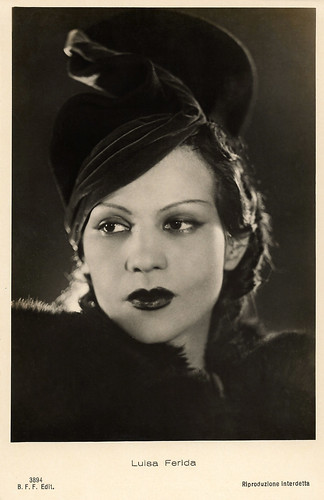
Italian postcard by B.F.F. Edit. (Casa Editr. Ballerini & Fratini, Firenze), no. 3894. Photo: Bragaglia.
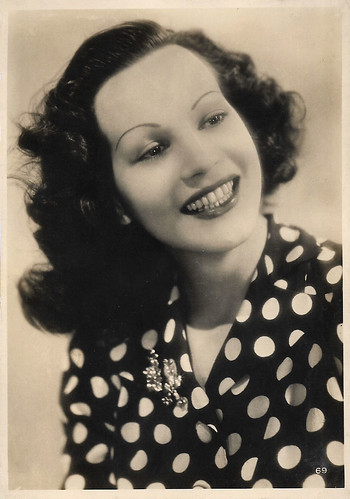
Italian postcard, no. 69. Photo: Bragaglia.
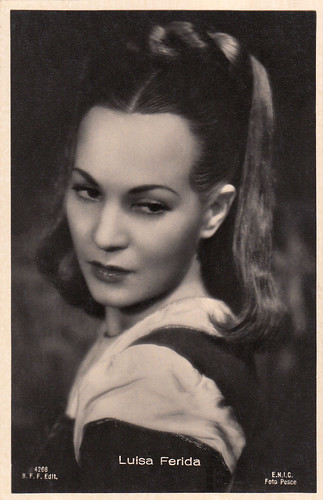
Italian postcard by B.F.F. Edit. (Ballerini & Fratini, Florence), no. 4266. Photo: Pesce / E.N.I.C. Luisa Ferida in La corona di ferro (Alessandro Blasetti, 1941). Collection: Marlène Pilaete.
An early attempt at realism in Italian cinema
Luisa Ferida was born Luigia Manfrini Frané in Castel San Pietro Terme, near Bologna, in 1914. Her father Luigi, a rich lander owner, died when she was a child.
She was then sent to a convent school.
Ferida started her career as a stage actress. In 1935 she made her first film appearance with a supporting role in the crime film La Freccia d'oro/Golden Arrow (Piero Ballerini, Corrado D'Errico, 1935). Because of her photogenic looks and talent as an actress, she soon graduated to leading roles in such films as the historical comedy Il re Burlone/The Joker King (Enrico Guazzoni, 1935) with Armando Falconi .
The following year, she appeared in the comedy Lo smemorato/The Amnesiac (Gennaro Righelli, 1936) starring Angelo Musco, the screwball comedy Amazzoni bianche/White Amazons (Gennaro Righelli, 1936) starring Paola Barbara , and the historical comedy L'ambasciatore/The Ambassador (Baldassarre Negroni, 1936) starring Leda Gloria .
She starred opposite Antonio Centa in the romantic comedy I tre desideri/The Three Wishes (Giorgio Ferroni, Kurt Gerron, 1937) of which also a Dutch-language version was made - without Ferida.
Next, she appeared opposite Amedeo Nazzari in the drama La fossa degli angeli/Tomb of the Angels (Carlo Ludovico Bragaglia, 1937). Roberto Rossellini co-wrote the screenplay and served as assistant director. It was shot on location in the Apuan Alps in Liguria and is set amidst the marble quarries of the area. It marked an early attempt at realism in Italian cinema, anticipating neorealism of the postwar era, and it celebrated Italy's industrial strength in line with the propaganda of the Mussolini regime.
She co-starred with Totò in the comedy Animali pazzi/Mad Animals (Carlo Ludovico Bragaglia, 1939). In 1939, while working on the Swashbuckler Un Avventura di Salvator Rosa/An Adventure of Salvator Rosa (Alessandro Blasetti, 1940), Luisa Ferida met the actor Osvaldo Valenti. The pair became romantically involved and had a son, Kim, who died 4 days after his birth. Valenti had been linked with many Fascist officials and personalities for years and he eventually joined the Italian Social Republic, and for these reasons, he was on the partisans' hit list.
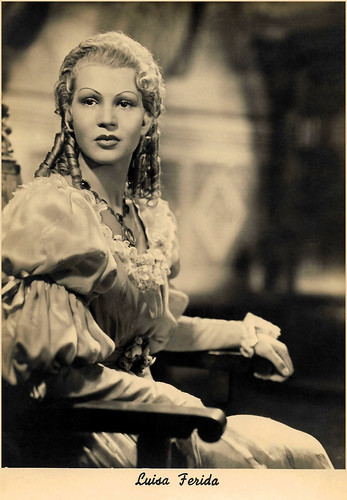
Italian postcard by Superbrom / Alterocca, Terni, no. 2425. Photo: E.I.A. Columbia. Luisa Ferida as Princess Elisabeth of Russia in Amore imperiale/Imperial love (Alexandre Volkoff, 1941).
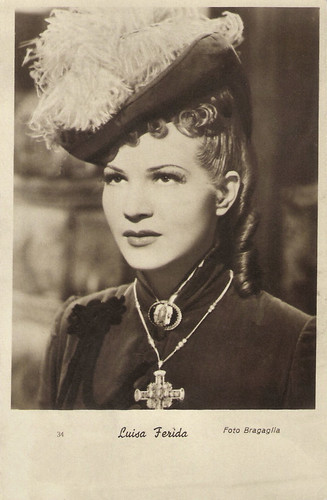
Italian postcard by DITTA Iris, Terni, no. 34. Photo: Bragaglia. Luisa Ferida in Fedora (Camillo Mastrocinque, 1942).
A screenplay by Federico Fellini
In the first half of the 1940s, Luisa Ferida's career was at its zenith, and she played memorable roles in such films as La fanciulla di Portici/The girl from Portici (Mario Bonnard, 1940), La corona di ferro/The Iron Crown (Alessandro Blasetti, 1941), and the drama Gelosia/Jealousy (Ferdinando Maria Poggioli, 1942).
She had a supporting role in the drama Nozze di sangue/Blood Wedding (Goffredo Alessandrini, 1941) starring Beatrice Mancini, and Fosco Giachetti . The film about an arranged marriage in 19th century South America, is based on the Spanish play by Federico Garcia Lorca.
She played the lead in the historical drama Fedora (Camillo Mastrocinque, 1942) opposite Amedeo Nazzari and Osvaldo Valenti. Opposite Fosco Giacchetti , she starred in the drama Fari nella nebbia/Headlights in the Fog (Gianni Franciolini, 1942). The film about a group of truck drivers is considered to be part of the development of Neorealism, which emerged around this time.
She starred with Osvaldo Valenti in the adventure film I cavalieri del deserto/Knights of the Desert (Gino Talamo, Osvaldo Valenti, 1942) with a screenplay by Federico Fellini and Vittorio Mussolini, the son of Italy's dictator Benito Mussolini. It was produced by the Rome-based ACI which was run by Vittorio Mussolini and shot on location in Libya before the North African Campaign turned decisively against Italy and its Allies. Fellini may have directed some of the Libyan scenes after Gino Talamo was injured in a car accident. The film was ultimately never released due to the defeats suffered in Libya, which meant its plot was now a potential embarrassment to the regime.
She appeared again with Valenti in the extremely popular historical film La cena delle beffe/The Jester's Supper (Alessandro Blasetti, 1942), also starring Amedeo Nazzari and Clara Calamai . The film is set in the 15th century Florence of Lorenzo the Magnificent and portrays a rivalry that leads to a series of increasingly violent jokes.
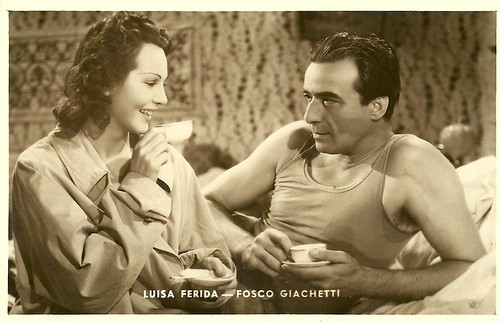
Italian postcard by Agfa. Fosco Giachetti and Luisa Ferida in Fari nella nebbia/Headlights in the Fog (Gianni Franciolini, 1942). In this dark, sensual and one might even say proto-Neorealist truckdriver's melodrama Cesare (Giachetti) befriends a wild girl (Ferida) after his wife ( Mariella Lotti ) has run away.
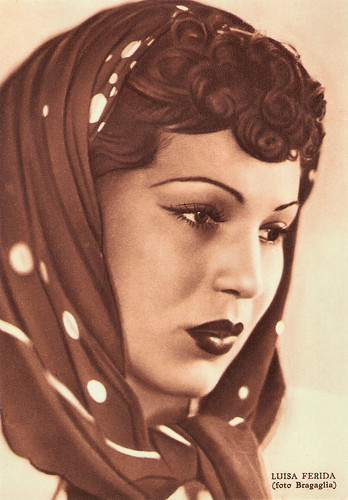
Italian postcard by Rizzoli & C., Milano, 1937. Photo: Bragaglia.

Italian postcard by Rizzoli & C., Milano, 1938. Photo: Bragaglia. Perhaps made for La fossa degli angeli (Curt Alexander, Carlo Ludovico Bragaglia, 1937).
Sentenced to be executed and shot immediately in the street
Luisa Ferida again co-starred with Valenti and Nazzari in the drama Sleeping Beauty (Luigi Chiarini, 1942), which belongs to the films of the Calligrafismo style. Calligrafismo is in sharp contrast to the Telefoni Bianchi-American style comedies and is rather artistic, highly formalistic, expressive in complexity, and deals mainly with contemporary literary material. In 1942 she won the Best Italian Actress award.
In the historical comedy La locandiera/The Innkeeper (Luigi Chiarini, 1944), she co-starred again with Armando Falconi and Osvaldo Valenti. During the last stages of completion, Mussolini was overthrown. The final editing was done in Venice, the film capital of the Italian Social Republic, but without the presence of Chiarini.
At the end of 1943, the fascist government of the Republic of Salo decided to create an Italian cinematographic center in the north of the country. Luisa Ferida and Valenti agreed to go there. They made Un fatto di cronaca/A Chronicle (Piero Ballerini, 1945), which was released in February 1945.
Two months later, Valenti was finally arrested in Milan, alongside a pregnant Ferida. They were both sentenced to be executed and shot immediately in the street, without a proper trial. The pregnant Ferida had a blue shoe of her deceased son Kim in her hand when she was killed. Opinions are divided as to whether the couple deserved this fatal fate.
The twelve suitcases of the couple, full of clothes, furs, money, and jewels were stolen that day. Her Milanese house was burglarised a few days later. The partisan chief who organised the execution, Giuseppe 'Vero' Marozin, declared years later that one of the partisan leaders that ordered the two actors to be executed was Sandro Pertini, who decades later became president of the Italian republic. No other source, however, supports Marozin's version of the incident.
Her mother Lucia asked for support from the Italian government since her daughter was her only support. After the actress was cleared of charges during the 1950s, Lucia received a small monthly pension. She died in poverty. Both lovers' graves are side to side in Cimitero Maggiore di Musocco in Milan. The film Sanguepazzo/Wild Blood (Marco Tullio Giordana, 2008) starring Monica Bellucci and Luca Zingaretti, discusses Luisa Ferida's relationship with Osvaldo Valenti.
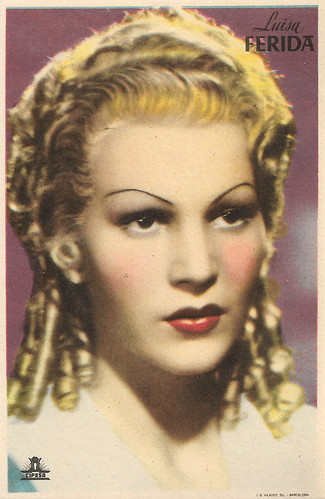
Spanish collectors card by I.G. Viladot, Barcelona. Image: Cifesa. Luisa Ferida as Princess Elisabeth of Russia in Amore imperiale/Imperial Love (Alexandre Volkoff, 1941).
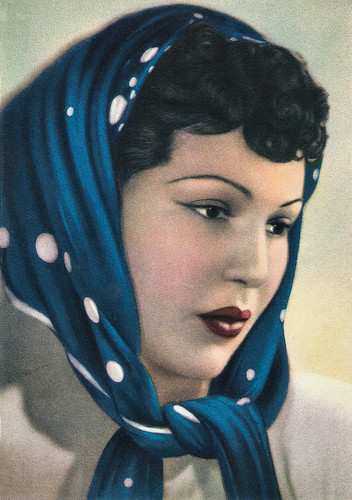
Italian postcard by NMM. Photo: Bragaglia.
Sources: Marlene Pilaete (La collectionneuse - French), (IMDb), Find-A-Grave, Wikipedia, and .

Italian postcard by B.F.F. Edit. (Casa Editr. Ballerini & Fratini, Firenze), no. 3894. Photo: Bragaglia.

Italian postcard, no. 69. Photo: Bragaglia.

Italian postcard by B.F.F. Edit. (Ballerini & Fratini, Florence), no. 4266. Photo: Pesce / E.N.I.C. Luisa Ferida in La corona di ferro (Alessandro Blasetti, 1941). Collection: Marlène Pilaete.
An early attempt at realism in Italian cinema
Luisa Ferida was born Luigia Manfrini Frané in Castel San Pietro Terme, near Bologna, in 1914. Her father Luigi, a rich lander owner, died when she was a child.
She was then sent to a convent school.
Ferida started her career as a stage actress. In 1935 she made her first film appearance with a supporting role in the crime film La Freccia d'oro/Golden Arrow (Piero Ballerini, Corrado D'Errico, 1935). Because of her photogenic looks and talent as an actress, she soon graduated to leading roles in such films as the historical comedy Il re Burlone/The Joker King (Enrico Guazzoni, 1935) with Armando Falconi .
The following year, she appeared in the comedy Lo smemorato/The Amnesiac (Gennaro Righelli, 1936) starring Angelo Musco, the screwball comedy Amazzoni bianche/White Amazons (Gennaro Righelli, 1936) starring Paola Barbara , and the historical comedy L'ambasciatore/The Ambassador (Baldassarre Negroni, 1936) starring Leda Gloria .
She starred opposite Antonio Centa in the romantic comedy I tre desideri/The Three Wishes (Giorgio Ferroni, Kurt Gerron, 1937) of which also a Dutch-language version was made - without Ferida.
Next, she appeared opposite Amedeo Nazzari in the drama La fossa degli angeli/Tomb of the Angels (Carlo Ludovico Bragaglia, 1937). Roberto Rossellini co-wrote the screenplay and served as assistant director. It was shot on location in the Apuan Alps in Liguria and is set amidst the marble quarries of the area. It marked an early attempt at realism in Italian cinema, anticipating neorealism of the postwar era, and it celebrated Italy's industrial strength in line with the propaganda of the Mussolini regime.
She co-starred with Totò in the comedy Animali pazzi/Mad Animals (Carlo Ludovico Bragaglia, 1939). In 1939, while working on the Swashbuckler Un Avventura di Salvator Rosa/An Adventure of Salvator Rosa (Alessandro Blasetti, 1940), Luisa Ferida met the actor Osvaldo Valenti. The pair became romantically involved and had a son, Kim, who died 4 days after his birth. Valenti had been linked with many Fascist officials and personalities for years and he eventually joined the Italian Social Republic, and for these reasons, he was on the partisans' hit list.

Italian postcard by Superbrom / Alterocca, Terni, no. 2425. Photo: E.I.A. Columbia. Luisa Ferida as Princess Elisabeth of Russia in Amore imperiale/Imperial love (Alexandre Volkoff, 1941).

Italian postcard by DITTA Iris, Terni, no. 34. Photo: Bragaglia. Luisa Ferida in Fedora (Camillo Mastrocinque, 1942).
A screenplay by Federico Fellini
In the first half of the 1940s, Luisa Ferida's career was at its zenith, and she played memorable roles in such films as La fanciulla di Portici/The girl from Portici (Mario Bonnard, 1940), La corona di ferro/The Iron Crown (Alessandro Blasetti, 1941), and the drama Gelosia/Jealousy (Ferdinando Maria Poggioli, 1942).
She had a supporting role in the drama Nozze di sangue/Blood Wedding (Goffredo Alessandrini, 1941) starring Beatrice Mancini, and Fosco Giachetti . The film about an arranged marriage in 19th century South America, is based on the Spanish play by Federico Garcia Lorca.
She played the lead in the historical drama Fedora (Camillo Mastrocinque, 1942) opposite Amedeo Nazzari and Osvaldo Valenti. Opposite Fosco Giacchetti , she starred in the drama Fari nella nebbia/Headlights in the Fog (Gianni Franciolini, 1942). The film about a group of truck drivers is considered to be part of the development of Neorealism, which emerged around this time.
She starred with Osvaldo Valenti in the adventure film I cavalieri del deserto/Knights of the Desert (Gino Talamo, Osvaldo Valenti, 1942) with a screenplay by Federico Fellini and Vittorio Mussolini, the son of Italy's dictator Benito Mussolini. It was produced by the Rome-based ACI which was run by Vittorio Mussolini and shot on location in Libya before the North African Campaign turned decisively against Italy and its Allies. Fellini may have directed some of the Libyan scenes after Gino Talamo was injured in a car accident. The film was ultimately never released due to the defeats suffered in Libya, which meant its plot was now a potential embarrassment to the regime.
She appeared again with Valenti in the extremely popular historical film La cena delle beffe/The Jester's Supper (Alessandro Blasetti, 1942), also starring Amedeo Nazzari and Clara Calamai . The film is set in the 15th century Florence of Lorenzo the Magnificent and portrays a rivalry that leads to a series of increasingly violent jokes.

Italian postcard by Agfa. Fosco Giachetti and Luisa Ferida in Fari nella nebbia/Headlights in the Fog (Gianni Franciolini, 1942). In this dark, sensual and one might even say proto-Neorealist truckdriver's melodrama Cesare (Giachetti) befriends a wild girl (Ferida) after his wife ( Mariella Lotti ) has run away.

Italian postcard by Rizzoli & C., Milano, 1937. Photo: Bragaglia.

Italian postcard by Rizzoli & C., Milano, 1938. Photo: Bragaglia. Perhaps made for La fossa degli angeli (Curt Alexander, Carlo Ludovico Bragaglia, 1937).
Sentenced to be executed and shot immediately in the street
Luisa Ferida again co-starred with Valenti and Nazzari in the drama Sleeping Beauty (Luigi Chiarini, 1942), which belongs to the films of the Calligrafismo style. Calligrafismo is in sharp contrast to the Telefoni Bianchi-American style comedies and is rather artistic, highly formalistic, expressive in complexity, and deals mainly with contemporary literary material. In 1942 she won the Best Italian Actress award.
In the historical comedy La locandiera/The Innkeeper (Luigi Chiarini, 1944), she co-starred again with Armando Falconi and Osvaldo Valenti. During the last stages of completion, Mussolini was overthrown. The final editing was done in Venice, the film capital of the Italian Social Republic, but without the presence of Chiarini.
At the end of 1943, the fascist government of the Republic of Salo decided to create an Italian cinematographic center in the north of the country. Luisa Ferida and Valenti agreed to go there. They made Un fatto di cronaca/A Chronicle (Piero Ballerini, 1945), which was released in February 1945.
Two months later, Valenti was finally arrested in Milan, alongside a pregnant Ferida. They were both sentenced to be executed and shot immediately in the street, without a proper trial. The pregnant Ferida had a blue shoe of her deceased son Kim in her hand when she was killed. Opinions are divided as to whether the couple deserved this fatal fate.
The twelve suitcases of the couple, full of clothes, furs, money, and jewels were stolen that day. Her Milanese house was burglarised a few days later. The partisan chief who organised the execution, Giuseppe 'Vero' Marozin, declared years later that one of the partisan leaders that ordered the two actors to be executed was Sandro Pertini, who decades later became president of the Italian republic. No other source, however, supports Marozin's version of the incident.
Her mother Lucia asked for support from the Italian government since her daughter was her only support. After the actress was cleared of charges during the 1950s, Lucia received a small monthly pension. She died in poverty. Both lovers' graves are side to side in Cimitero Maggiore di Musocco in Milan. The film Sanguepazzo/Wild Blood (Marco Tullio Giordana, 2008) starring Monica Bellucci and Luca Zingaretti, discusses Luisa Ferida's relationship with Osvaldo Valenti.

Spanish collectors card by I.G. Viladot, Barcelona. Image: Cifesa. Luisa Ferida as Princess Elisabeth of Russia in Amore imperiale/Imperial Love (Alexandre Volkoff, 1941).

Italian postcard by NMM. Photo: Bragaglia.
Sources: Marlene Pilaete (La collectionneuse - French), (IMDb), Find-A-Grave, Wikipedia, and .
Published on September 29, 2020 22:00
September 28, 2020
City Lights (1931)
Charles Chaplin played the Tramp through dozens of short films and, later, feature-length productions. In only a handful of films, he played characters other than the little tramp. The Tramp was closely identified with the silent era and was considered an international character. When the sound era began in the late 1920s, Chaplin refused to make a talkie featuring the character. City Lights (1931) featured no dialogue.
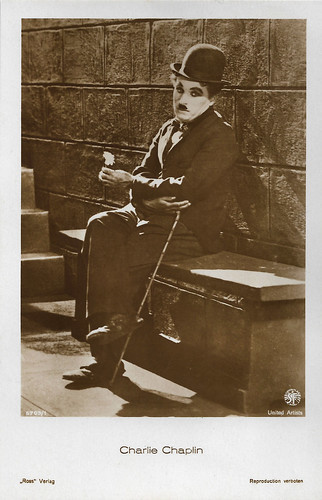
German postcard by Ross Verlag, no. 5709/1, 1930-1931. Photo: SF / United Artists. Charlie Chaplin in City Lights (Charles Chaplin, 1931).
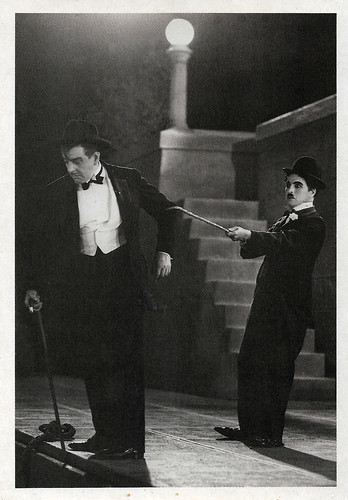
French postcard in the 'Centenaire de la Naissance de Charlie Chaplin 1889-1989' series by Bubbles Inc., Star 150, 1989. Photo: United Artists. Charlie Chaplin and Harry Myers in City Lights (Charles Chaplin, 1931).
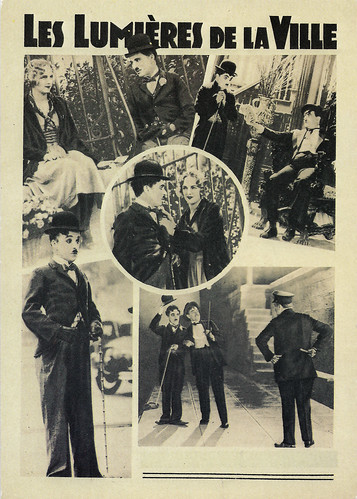
French postcard in the 'Centenaire de la Naissance de Charlie Chaplin 1889-1989' series by Bubbles Inc., Star 175, 1989. Photo: United Artists. Charlie Chaplin in City Lights (Charles Chaplin, 1931).
Finally, a living, breathing human being
Charles Chaplin called his last 'silent' film a 'Comedy Romance in Pantomime'. City Lights (1931) opens in the early morning where the mayor is dedicating a statue to the citizens of the city. After the unveiling, the crowd finds a little tramp ( Charlie Chaplin ) sleeping on the lap of one of the figures. As he tries to climb down, he encounters one problem after another.
City Lights (1931) tells the story of the beloved little tramp who falls in love with a blind flower girl (Virginia Cherrill) on the sidewalk. Charlie meets her when waddling down the street with his cane and derby hat, and that tiny moustache. While examining a nude statue in a shop, he is annoyed by some newsboys making fun of his tattered clothing. Then he sees the beautiful, blonde flower girl sitting at the sidewalk. After she drops the flower, Charlie notices her feeling about the sidewalk for it, thus, realising she's blind. She assumes he is a wealthy man and offers him a flower. He attentively accepts the flower with his last penny.
The noble little fellow fancies himself as a well-mannered gentleman in spite of all the circumstances that bring him down. One night by chance he meets a depressed and drunken millionaire (Harry Myers) who attempts to commit suicide by drowning. Just as Charlie is about to save him, he in turn falls into the river. The suicide attempt at the canal is one of the many comic highlights in the film.
The drunk, in gratitude for saving his life, takes Charlie under his wing to accompany him to various night clubs until dawn. By morning, the millionaire, now sober, fails to recognise or remember Charlie and orders his butler to escort this stranger out of his mansion. However, when drunk, the wealthy businessman continues to try to commit suicide. The tramp persuades the drunken millionaire not to go through with it, making himself a devoted friend. The rich gentleman becomes a generous friend.
To impress the flower girl the poor tramp uses his friend's wealth to make her fall in love with him. The only problem is that when the millionaire is sober he doesn't recognise the tramp any more. The flower girl has to pay 22 dollars of rent or she will be thrown out of her apartment. Now the tramp desperately seeks for jobs in the city to help his love to pay the rent and to get money for eye surgery. He works as a street cleaner but loses this and various other jobs. His desperate attempt to win money with boxing leads to a magical, hilariously funny boxing match.
Reading in a newspaper of a European doctor who restores sight for the blind, Charlie gives the girl $1,000 for an operation, the money offered to him by the drunken millionaire, who, after sober, accuses Charlie of robbing him, has his arrested and serving jail time.
The last five minutes of the film are heartbreaking. When the little tramp is out of prison, he meets the formerly blind girl again. She offers him a flower and when she finally says "Yes, I can see now", she realises that the little tramp is the 'wealthy' gentleman who paid for the restoration of her sight.
City Lights is a timeless classic. It displays the Tramp at his funniest, his bravest, his most romantic, and his most sympathetic. He blends into everyday life and is more or less ignored by many, laughed at by others. And only when the millionaire is drunk does he 'see' the tramp as a friend. In the final scene, when the flower girl finally sees him, Chaplin's former slapstick character has become a living, breathing human being.
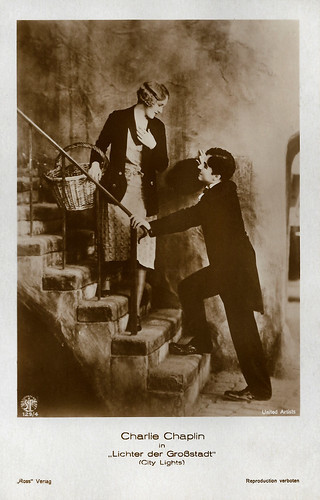
German postcard by Ross Verlag, no. 129/4. Photo: United Artists / SF. Charlie Chaplin and Virginia Cherrill in City Lights (Charles Chaplin, 1931).
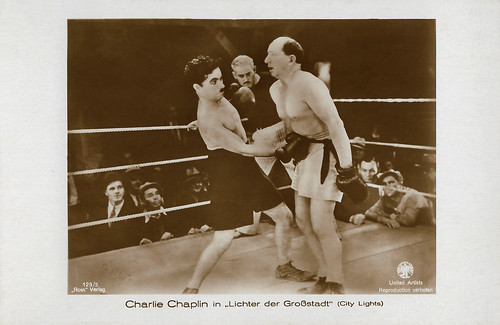
German postcard by Ross Verlag, no. 129/5, 1930-1931. Photo: SF / United Artists. Charlie Chaplin , Eddie Baker, and Hank Mann in City Lights (Charles Chaplin, 1931).
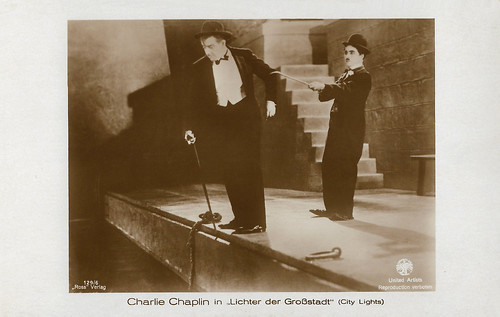
German postcard by Ross Verlag, no. 129/6. Photo: United Artists / SF. Charlie Chaplin and Harry Myers in City Lights (Charles Chaplin, 1931).
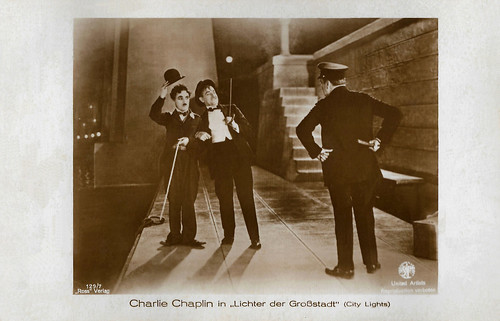
German postcard by Ross Verlag, no. 129/7. Photo: United Artists. Charlie Chaplin and Harry Myers in City Lights (Charles Chaplin, 1931).
Source: IMDb.

German postcard by Ross Verlag, no. 5709/1, 1930-1931. Photo: SF / United Artists. Charlie Chaplin in City Lights (Charles Chaplin, 1931).

French postcard in the 'Centenaire de la Naissance de Charlie Chaplin 1889-1989' series by Bubbles Inc., Star 150, 1989. Photo: United Artists. Charlie Chaplin and Harry Myers in City Lights (Charles Chaplin, 1931).

French postcard in the 'Centenaire de la Naissance de Charlie Chaplin 1889-1989' series by Bubbles Inc., Star 175, 1989. Photo: United Artists. Charlie Chaplin in City Lights (Charles Chaplin, 1931).
Finally, a living, breathing human being
Charles Chaplin called his last 'silent' film a 'Comedy Romance in Pantomime'. City Lights (1931) opens in the early morning where the mayor is dedicating a statue to the citizens of the city. After the unveiling, the crowd finds a little tramp ( Charlie Chaplin ) sleeping on the lap of one of the figures. As he tries to climb down, he encounters one problem after another.
City Lights (1931) tells the story of the beloved little tramp who falls in love with a blind flower girl (Virginia Cherrill) on the sidewalk. Charlie meets her when waddling down the street with his cane and derby hat, and that tiny moustache. While examining a nude statue in a shop, he is annoyed by some newsboys making fun of his tattered clothing. Then he sees the beautiful, blonde flower girl sitting at the sidewalk. After she drops the flower, Charlie notices her feeling about the sidewalk for it, thus, realising she's blind. She assumes he is a wealthy man and offers him a flower. He attentively accepts the flower with his last penny.
The noble little fellow fancies himself as a well-mannered gentleman in spite of all the circumstances that bring him down. One night by chance he meets a depressed and drunken millionaire (Harry Myers) who attempts to commit suicide by drowning. Just as Charlie is about to save him, he in turn falls into the river. The suicide attempt at the canal is one of the many comic highlights in the film.
The drunk, in gratitude for saving his life, takes Charlie under his wing to accompany him to various night clubs until dawn. By morning, the millionaire, now sober, fails to recognise or remember Charlie and orders his butler to escort this stranger out of his mansion. However, when drunk, the wealthy businessman continues to try to commit suicide. The tramp persuades the drunken millionaire not to go through with it, making himself a devoted friend. The rich gentleman becomes a generous friend.
To impress the flower girl the poor tramp uses his friend's wealth to make her fall in love with him. The only problem is that when the millionaire is sober he doesn't recognise the tramp any more. The flower girl has to pay 22 dollars of rent or she will be thrown out of her apartment. Now the tramp desperately seeks for jobs in the city to help his love to pay the rent and to get money for eye surgery. He works as a street cleaner but loses this and various other jobs. His desperate attempt to win money with boxing leads to a magical, hilariously funny boxing match.
Reading in a newspaper of a European doctor who restores sight for the blind, Charlie gives the girl $1,000 for an operation, the money offered to him by the drunken millionaire, who, after sober, accuses Charlie of robbing him, has his arrested and serving jail time.
The last five minutes of the film are heartbreaking. When the little tramp is out of prison, he meets the formerly blind girl again. She offers him a flower and when she finally says "Yes, I can see now", she realises that the little tramp is the 'wealthy' gentleman who paid for the restoration of her sight.
City Lights is a timeless classic. It displays the Tramp at his funniest, his bravest, his most romantic, and his most sympathetic. He blends into everyday life and is more or less ignored by many, laughed at by others. And only when the millionaire is drunk does he 'see' the tramp as a friend. In the final scene, when the flower girl finally sees him, Chaplin's former slapstick character has become a living, breathing human being.

German postcard by Ross Verlag, no. 129/4. Photo: United Artists / SF. Charlie Chaplin and Virginia Cherrill in City Lights (Charles Chaplin, 1931).

German postcard by Ross Verlag, no. 129/5, 1930-1931. Photo: SF / United Artists. Charlie Chaplin , Eddie Baker, and Hank Mann in City Lights (Charles Chaplin, 1931).

German postcard by Ross Verlag, no. 129/6. Photo: United Artists / SF. Charlie Chaplin and Harry Myers in City Lights (Charles Chaplin, 1931).

German postcard by Ross Verlag, no. 129/7. Photo: United Artists. Charlie Chaplin and Harry Myers in City Lights (Charles Chaplin, 1931).
Source: IMDb.
Published on September 28, 2020 22:00
September 27, 2020
Wallace Reid
Wallace Reid (1891–1923) was an American actor in the silent film referred to as "the screen's most perfect lover". He debuted at Selig but soon rose to popularity at Vitagraph and Universal. Later he moved to Paramount, where he starred as a dashing daredevil in popular race-car films. A morphine addiction killed him, at the age of only 31.
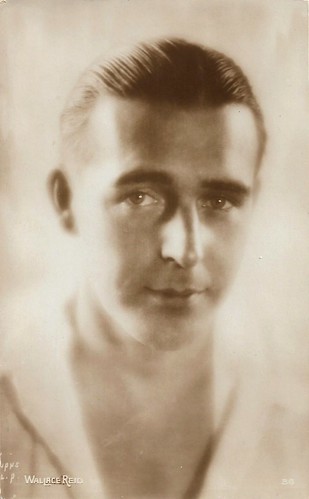
French postcard by Cinémagazine-Edition, no. 36. Photo: Evans, L.A.
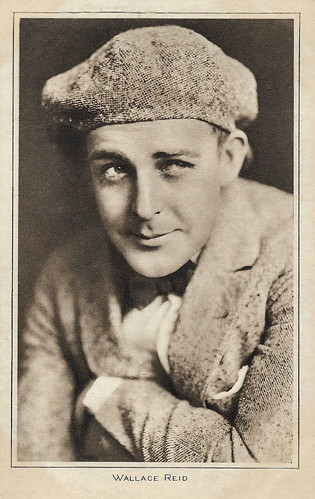
British postcard by 'Pictures' Portrait Gallery, London, by Pictures Ltd. London, no. 145.
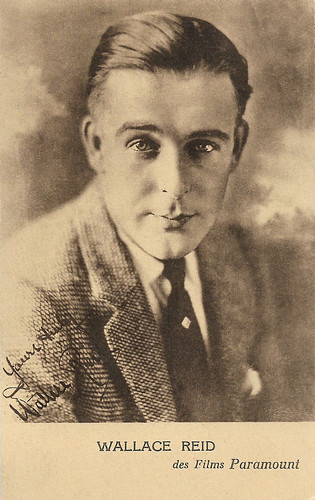
French postcard by Editions Paramount, Paris.
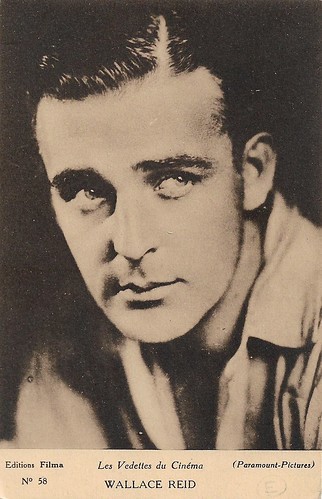
French postcard in the Les Vedettes du Cinéma series by Editions Filma, no. 58. Photo: Paramount Pictures.
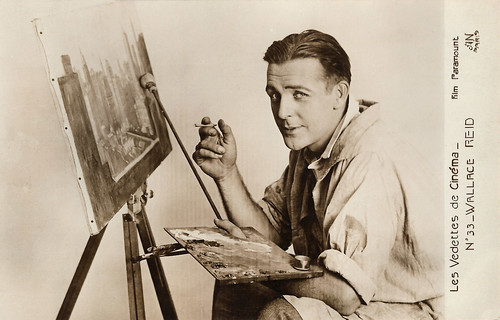
French postcard in the Les Vedettes de Cinéma series by A.N., Paris, no. 33. Photo: Film Paramount.
En route to becoming one of Hollywood's major heartthrobs
William Wallace Halleck Reid was born in St. Louis, Missouri, in a vaudeville family in 1891. His mother, Bertha Westbrook, was an actress, and his father, James Halleck "Hal" Reid, worked successfully in a variety of theatrical jobs, mainly as playwright and actor, traveling the country.
As a boy, Wallace Reid was performing on stage at the age of four in the act with his parents, but the acting was put on hold while he obtained his education at Freehold Military School in Freehold Township, New Jersey. He managed a football team and ran the school newspaper. He later graduated from Perkiomen Seminary in Pennsburg, Pennsylvania, in 1909. Wallace was now an all-around athlete and gifted musician.
When his father entered the film business in 1910, he brought along his teenage son who wanted to be a cameraman. However, with his athletic good looks, he was often put in front of the camera instead of behind. In 1910, Reid appeared as a reporter in his first film, The Phoenix (N.N., 1910), an adaptation of a Milton Nobles play, filmed at Selig Polyscope Studios in Chicago.
He was soon acting and directing with and for early film mogul Allan Dwan. Reid played in some 100 shorts. Although Reid's good looks and powerful physique made him the perfect matinée idol, he was equally happy with the roles behind the scenes and often worked as a writer, cameraman, and director.
In 1913, while at Universal Pictures, Reid met and married actress Dorothy Davenport. She was only seventeen, but already a veteran of the stage and screen. Davenport was one of the stars that he both directed and starred with.
Reid had parts in such famous feature films like Birth of a nation (1915) and Intolerance (1916) by D. W. Griffith. He also starred opposite leading ladies such as Florence Turner, Gloria Swanson , Lillian Gish , Elsie Ferguson, and Geraldine Farrar en route to becoming one of Hollywood's major heartthrobs.
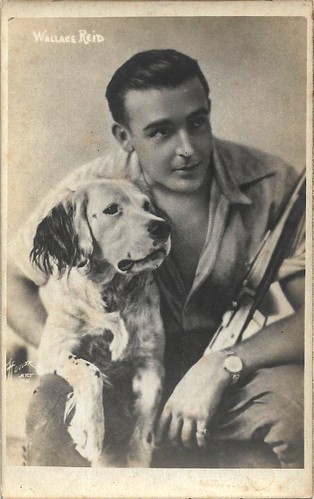
Vintage postcard. Photo: Hoover Art Co.
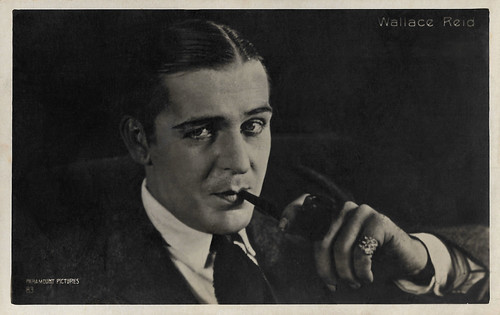
Italian postcard by B & G B, no. 83. Photo: Paramount Pictures.
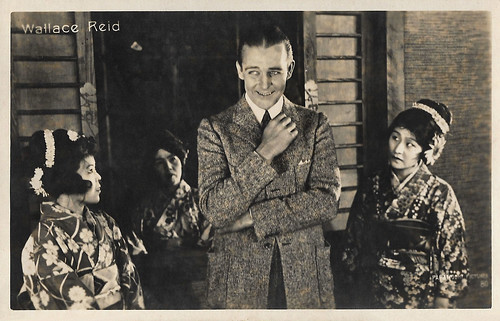
Italian postcard by G. Vettori, Bologna, no. 80. Photo: Paramount Pictures.
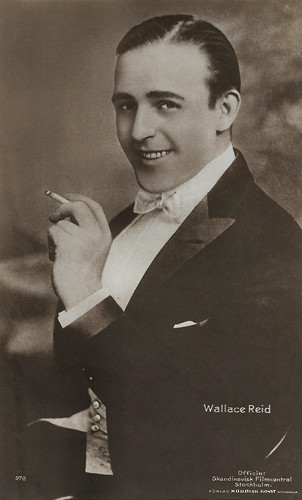
Swedish postcard by Förlag Nordisk Konst, Stockholm, no. 978. Photo: Skandinavisk Filmcentral, Stockholm.
Daredevil auto thrillers
Then Reid was signed by producer Jesse L. Lasky for some 60 more films at Lasky's Famous Players film company, which later became Paramount Pictures. Wallace went on to star in a series of pictures in which he represented all that was best of the ideal American.
His action-hero role as the dashing race-car driver drew young girls and older women alike to theatres to see his daredevil auto thrillers such as The Roaring Road (James Cruze, 1919) with Ann Little, Double Speed (Sam Wood, 1920), Excuse My Dust (Sam Wood, 1920), and Too Much Speed (Frank Urson, 1921). Reid was so fond of racing that he even joined an Indianapolis race in 1922.
En route to Oregon for the filming of The Valley of the Giants (James Cruze, 1919), Reid was injured in a train wreck near Arcata, California, and needed six stitches to close a three-inch scalp wound. He was prescribed morphine for relief of his excruciating pain so he could continue filming. Reid soon became addicted but kept on working at a frantic pace in films that were growing more physically demanding and changing from 15–20 minutes in duration to as much as an hour.
Reid became depressed and his alcohol use got out of control, even though he was young, fit, and strong. Reid's morphine addiction worsened at a time when drug rehabilitation programs were nonexistent. Coupled with the alcohol, Wallace never had a chance and by 1922, he started entering a succession of hospitals and sanitariums as his health began to deteriorate rapidly.
Making his last film for the studio, Thirty Days (James Cruze, 1922), Wallace was barely able to stand, let alone act. Wallace Reid died in his wife's arms in a sanitarium in Los Angeles while attempting recovery in 1923. He was only 31. Wallace was the third major Paramount personality to be involved in a scandal in 1922.
His wife, Dorothy Davenport, co-produced and appeared (billed as Mrs. Wallace Reid) in Human Wreckage (John Griffith Wray, 1923). She did a national tour with the film to warn against the dangers of drugs. She and Reid had two children: a son, Wallace Reid Jr., born in 1917; and a daughter, Betty Mummert, whom they adopted in 1922 as a three-year-old. Allegedly Reid had fathered her during an affair. Davenport never remarried.
Wallace Reid's contribution to the film industry has been recognised with a star on the Hollywood Walk of Fame. In 2007, the biography 'Wallace Reid: Life and Death of a Hollywood Idol' by author E. J. Fleming appeared.
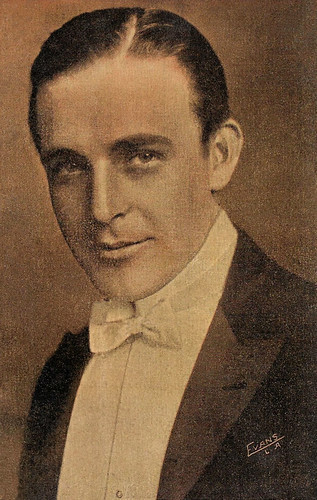
Spanish collector's card by Amatller Marca Luna, series 11, no. 20. Photo: Evans, L.A.
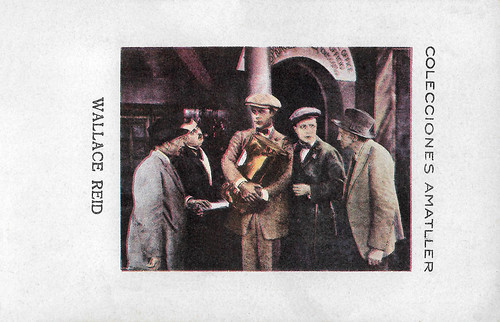
Spanish collectors card by Chocolate Amatller, series CC, artist 35, no. 77. Wallace Reid and Harrison Ford in Hawthorne of the U.S.A. (James Cruze, 1919). It is one of the few surviving films with Reid.
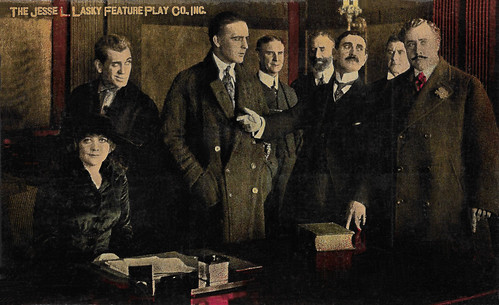
Spanish cromo (colored collectors card) by Chocolat Imperiale, no. 2 of 6 cards. Photo: Jesse Lasky / Paramount. Myrtle Stedman, Wallace Reid, and William Conklin in The Prison Without Walls (E. Mason Hopper, 1917), written by Beulah Marie Dix and Robert E. MacAlarney. The Spanish title for the film was Prisión sin muros.
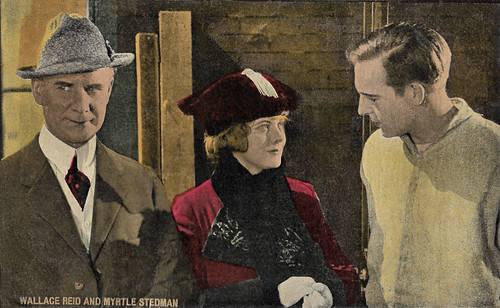
Spanish cromo (colored collectors card) by Chocolat Imperiale, no. 5 of 6 cards. Photo: Jesse Lasky / Paramount. Myrtle Stedman, and Wallace Reid in The Prison Without Walls (E. Mason Hopper, 1917). The old man may be James Neill.
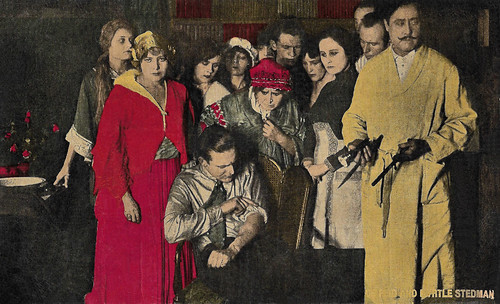
Spanish cromo (colored collectors card) by Chocolat Imperiale, no. 6 of 6 cards. Photo: Jesse Lasky / Paramount. Myrtle Stedman, Wallace Reid, Camille Ankewich, and William Conklin in The Prison Without Walls (E. Mason Hopper, 1917). The old lady could be Lillian Leighton.
Sources: (IMDb), Marta Monk (Find-A-Grave), Wikipedia, and .

French postcard by Cinémagazine-Edition, no. 36. Photo: Evans, L.A.

British postcard by 'Pictures' Portrait Gallery, London, by Pictures Ltd. London, no. 145.

French postcard by Editions Paramount, Paris.

French postcard in the Les Vedettes du Cinéma series by Editions Filma, no. 58. Photo: Paramount Pictures.

French postcard in the Les Vedettes de Cinéma series by A.N., Paris, no. 33. Photo: Film Paramount.
En route to becoming one of Hollywood's major heartthrobs
William Wallace Halleck Reid was born in St. Louis, Missouri, in a vaudeville family in 1891. His mother, Bertha Westbrook, was an actress, and his father, James Halleck "Hal" Reid, worked successfully in a variety of theatrical jobs, mainly as playwright and actor, traveling the country.
As a boy, Wallace Reid was performing on stage at the age of four in the act with his parents, but the acting was put on hold while he obtained his education at Freehold Military School in Freehold Township, New Jersey. He managed a football team and ran the school newspaper. He later graduated from Perkiomen Seminary in Pennsburg, Pennsylvania, in 1909. Wallace was now an all-around athlete and gifted musician.
When his father entered the film business in 1910, he brought along his teenage son who wanted to be a cameraman. However, with his athletic good looks, he was often put in front of the camera instead of behind. In 1910, Reid appeared as a reporter in his first film, The Phoenix (N.N., 1910), an adaptation of a Milton Nobles play, filmed at Selig Polyscope Studios in Chicago.
He was soon acting and directing with and for early film mogul Allan Dwan. Reid played in some 100 shorts. Although Reid's good looks and powerful physique made him the perfect matinée idol, he was equally happy with the roles behind the scenes and often worked as a writer, cameraman, and director.
In 1913, while at Universal Pictures, Reid met and married actress Dorothy Davenport. She was only seventeen, but already a veteran of the stage and screen. Davenport was one of the stars that he both directed and starred with.
Reid had parts in such famous feature films like Birth of a nation (1915) and Intolerance (1916) by D. W. Griffith. He also starred opposite leading ladies such as Florence Turner, Gloria Swanson , Lillian Gish , Elsie Ferguson, and Geraldine Farrar en route to becoming one of Hollywood's major heartthrobs.

Vintage postcard. Photo: Hoover Art Co.

Italian postcard by B & G B, no. 83. Photo: Paramount Pictures.

Italian postcard by G. Vettori, Bologna, no. 80. Photo: Paramount Pictures.

Swedish postcard by Förlag Nordisk Konst, Stockholm, no. 978. Photo: Skandinavisk Filmcentral, Stockholm.
Daredevil auto thrillers
Then Reid was signed by producer Jesse L. Lasky for some 60 more films at Lasky's Famous Players film company, which later became Paramount Pictures. Wallace went on to star in a series of pictures in which he represented all that was best of the ideal American.
His action-hero role as the dashing race-car driver drew young girls and older women alike to theatres to see his daredevil auto thrillers such as The Roaring Road (James Cruze, 1919) with Ann Little, Double Speed (Sam Wood, 1920), Excuse My Dust (Sam Wood, 1920), and Too Much Speed (Frank Urson, 1921). Reid was so fond of racing that he even joined an Indianapolis race in 1922.
En route to Oregon for the filming of The Valley of the Giants (James Cruze, 1919), Reid was injured in a train wreck near Arcata, California, and needed six stitches to close a three-inch scalp wound. He was prescribed morphine for relief of his excruciating pain so he could continue filming. Reid soon became addicted but kept on working at a frantic pace in films that were growing more physically demanding and changing from 15–20 minutes in duration to as much as an hour.
Reid became depressed and his alcohol use got out of control, even though he was young, fit, and strong. Reid's morphine addiction worsened at a time when drug rehabilitation programs were nonexistent. Coupled with the alcohol, Wallace never had a chance and by 1922, he started entering a succession of hospitals and sanitariums as his health began to deteriorate rapidly.
Making his last film for the studio, Thirty Days (James Cruze, 1922), Wallace was barely able to stand, let alone act. Wallace Reid died in his wife's arms in a sanitarium in Los Angeles while attempting recovery in 1923. He was only 31. Wallace was the third major Paramount personality to be involved in a scandal in 1922.
His wife, Dorothy Davenport, co-produced and appeared (billed as Mrs. Wallace Reid) in Human Wreckage (John Griffith Wray, 1923). She did a national tour with the film to warn against the dangers of drugs. She and Reid had two children: a son, Wallace Reid Jr., born in 1917; and a daughter, Betty Mummert, whom they adopted in 1922 as a three-year-old. Allegedly Reid had fathered her during an affair. Davenport never remarried.
Wallace Reid's contribution to the film industry has been recognised with a star on the Hollywood Walk of Fame. In 2007, the biography 'Wallace Reid: Life and Death of a Hollywood Idol' by author E. J. Fleming appeared.

Spanish collector's card by Amatller Marca Luna, series 11, no. 20. Photo: Evans, L.A.

Spanish collectors card by Chocolate Amatller, series CC, artist 35, no. 77. Wallace Reid and Harrison Ford in Hawthorne of the U.S.A. (James Cruze, 1919). It is one of the few surviving films with Reid.

Spanish cromo (colored collectors card) by Chocolat Imperiale, no. 2 of 6 cards. Photo: Jesse Lasky / Paramount. Myrtle Stedman, Wallace Reid, and William Conklin in The Prison Without Walls (E. Mason Hopper, 1917), written by Beulah Marie Dix and Robert E. MacAlarney. The Spanish title for the film was Prisión sin muros.

Spanish cromo (colored collectors card) by Chocolat Imperiale, no. 5 of 6 cards. Photo: Jesse Lasky / Paramount. Myrtle Stedman, and Wallace Reid in The Prison Without Walls (E. Mason Hopper, 1917). The old man may be James Neill.

Spanish cromo (colored collectors card) by Chocolat Imperiale, no. 6 of 6 cards. Photo: Jesse Lasky / Paramount. Myrtle Stedman, Wallace Reid, Camille Ankewich, and William Conklin in The Prison Without Walls (E. Mason Hopper, 1917). The old lady could be Lillian Leighton.
Sources: (IMDb), Marta Monk (Find-A-Grave), Wikipedia, and .
Published on September 27, 2020 22:00
Paul van Yperen's Blog
- Paul van Yperen's profile
- 13 followers
Paul van Yperen isn't a Goodreads Author
(yet),
but they
do have a blog,
so here are some recent posts imported from
their feed.



